The Year in Review 2018
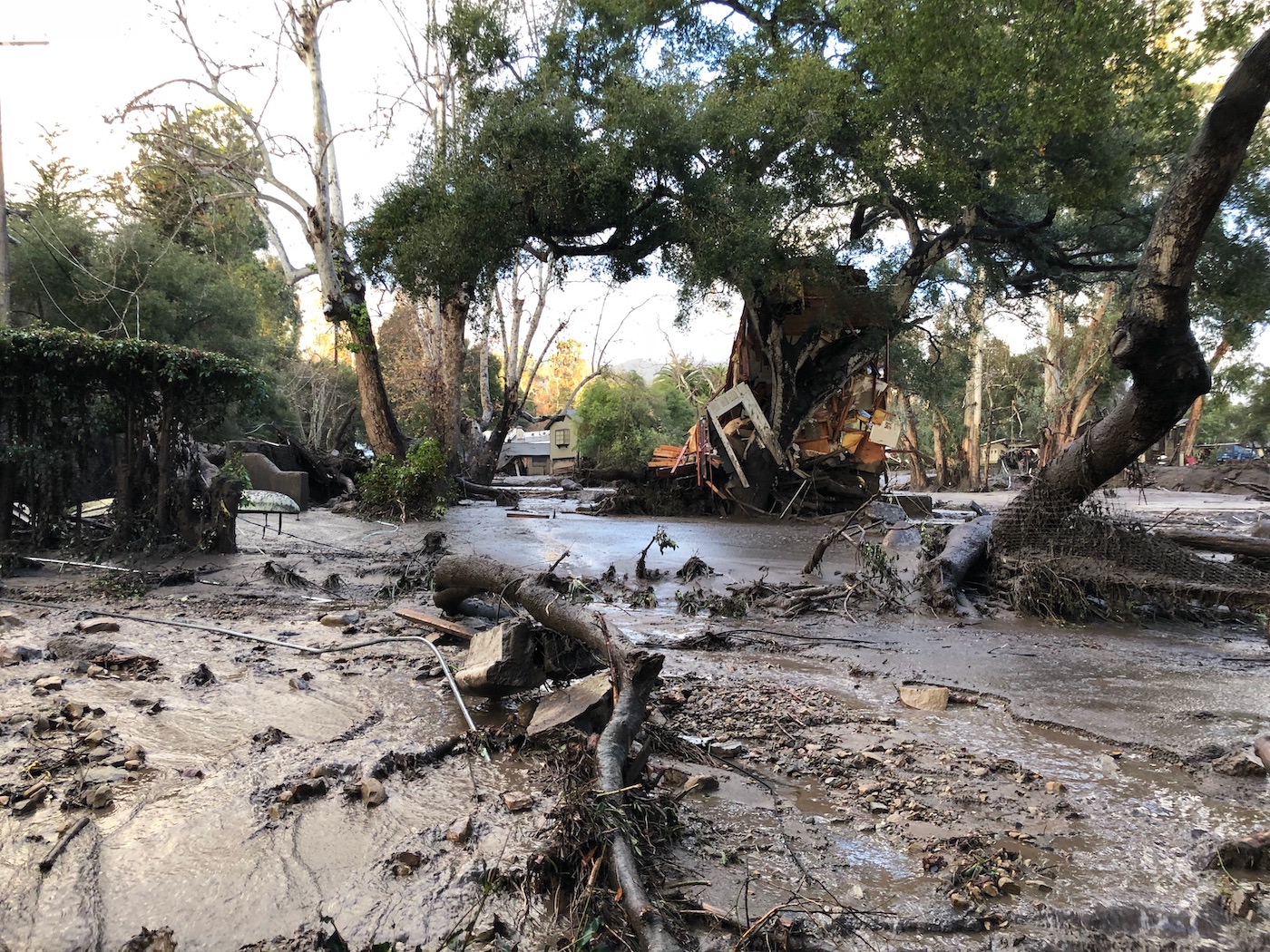
It is more than obvious that 2018 was a pivotal year for Montecito and its residents. The first week of the year, we were recovering from the Thomas Fire, which weeks earlier had suffocated Montecito and Santa Barbara in smoke and ash while scorching nearly 282,000 acres from Ventura to Santa Barbara, including ten structures in Montecito.
In the early morning hours of January 9, 2018, heavy rain caused multiple debris flows along the creek channels in Montecito. One of those caused the failure of a natural gas line that runs along East Mountain Drive; a massive explosion caused several homes to catch fire, lighting up the night sky and awakening many residents. Montecito Creek, which runs behind homes on Olive Mill Road and Hot Springs Road, overflowed, causing homes to come loose from their foundations and sending massive boulders and debris down Olive Mill Road to the ocean. Mud and debris made its way onto Coast Village Road, sending abandoned cars crashing into the front of Montecito Inn, and damaging several commercial buildings. The debris also overtook Highway 101, causing drivers who were evacuating to turn around on the freeway, searching for higher ground. Several of those drivers abandoned their vehicles and traversed on foot up the freeway embankments.
Montecito Fire Protection District received thousands of calls from residents needing rescue; people were on the second floors of their homes as well as their roofs, awaiting emergency responders. MFPD, with the help of other local and regional teams, performed an incredible amount of rescues. At the height of the incident, 2,100 responders were on the ground and in the air, rescuing and recovering people in the first week following the incident. Victims from burning homes were rescued, along with those stranded from the mudslides. Ten helicopters performed 18 hoists in the first two hours and 102 air rescues in the first 14 hours, an unprecedented amount of rescues in the rainy weather. Montecito endured catastrophic debris flow and flooding that in total, destroyed or significantly damaged 470 homes and structures, while taking the lives of 23 members of our community. Major damage occurred to our water system, sanitary system, and trail network.
Much of the content of this publication in the weeks following the disaster was dedicated to various aspects of the aftermath: complete evacuation followed by repopulation of Montecito, the massive cleanup efforts on private and public property, the plethora of resources available to victims, and the County’s plans to move forward, among other debris flow-related reporting.
Lives Lost
The casualties from the January 9 storm and subsequent mudslides/flooding include 30-year-old Pinit Sutthithepa, his son, six-year-old Peerawat “Pasta” Sutthithepa, and his father-in-law, 79-year-old Richard Loring Taylor. Faviola Benitez Calderon (28 years old), her ten-year-old son Jonathan Benitez and his cousin, three-year-old Kailly Benitez, as well as her mother, 27-year-old Marilyn Ramos, were also killed. Sisters Sawyer Corey (12 years old) and Morgan Corey (25 years old) are also among the dead. Other victims include 87-year-old Joseph Francis Bleckel, 48-year-old Martin Cabrera-Munoz, 49-year-old David Cantin, 73-year-old Peter Fleurat, 69-year-old Josephine Gower, 61-year-old John McManigal, 78-year-old Alice Mitchell, 89-year-old James Mitchell, Mark Montgomery (54) and his daughter Caroline Montgomery (22), 61-year-old Rebecca Riskin, and 84-year-old Roy Rohter. Seventeen-year-old Jack Cantin and two-year-old Lydia Sutthithepa remain missing as of this publication.
Recovery & Rebuilding
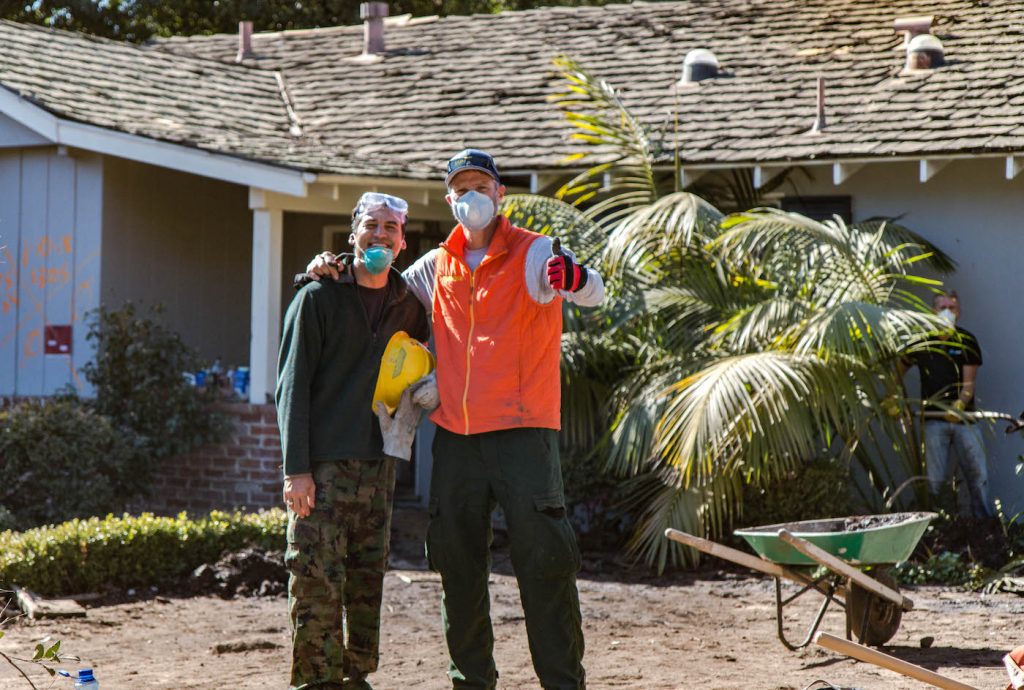
Immediately following the mudslide, residents had access to a Local Assistance Center, where they could find information about insurance claims, FEMA, short-term housing, support groups, counseling, and more. In early March, a semi-permanent facility was opened on Coast Village Circle, called Montecito Center, which was a hub for various outreach programs to help with the rebuilding process. The Center, which was open for six months, was led by Ben Romo and his team. The building space was donated by Paul Orfalea.
Just days after the mudslide, Montecito Fire Protection District board president Abe Powell, along with his wife Jessica Powell, Thomas and Linda Cole, and Josiah Hamilton, founded the Bucket Brigade, a non-profit organization which coordinated and deployed thousands of volunteers in the disaster zone to remove mud and debris from private property. The Brigade continues its work today, partnering with other local non-profits to clean out creek channels, trails, beaches, and pubic open spaces.
In early February, Montecito Water District lifted a boil water notice, giving the green light to the businesses in both the upper and lower villages that they could reopen their doors. A number of different events were planned to encourage people to visit the business districts, including a Cash Mob on Coast Village Road and a family-friendly music, food, and shopping event in the upper village. There were also countless benefit events, the largest being the Kick Ash Bash in February, which drew over 2,500 people to a celebrity-filled concert and carnival at Bella Vista Ranch. The benefit raised over $2 million, which was distributed to beneficiaries including Santa Barbara City Fire Department, Santa Barbara County Fire Department, Montecito Fire Protection District, Carpinteria/Summerland Fire Department, Santa Barbara City Police, Santa Barbara County Sheriff, At-Ease, Direct Relief, Santa Barbara Scholarship Foundation for SB County First Responders’ kids, Santa Barbara Equine Evacuation Program, Santa Barbara Search & Rescue, the US Forest Service, and the 93108Fund. Later in the spring, we also saw benefit concerts at the Santa Barbara Bowl by local celebrities Katy Perry, Brad Paisley, and Ellen DeGeneres.
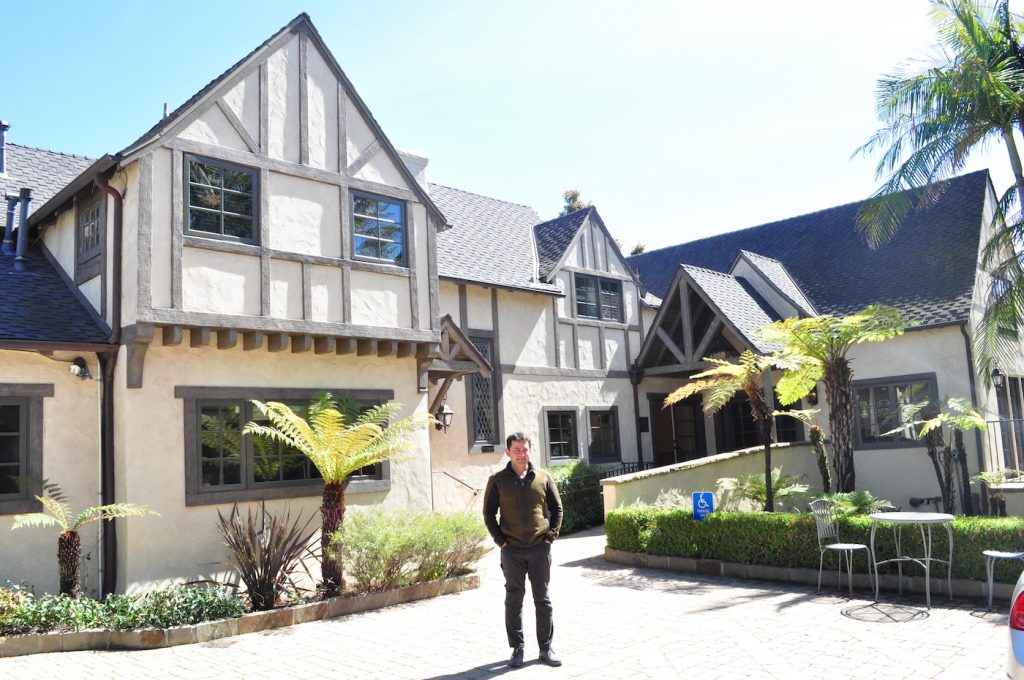
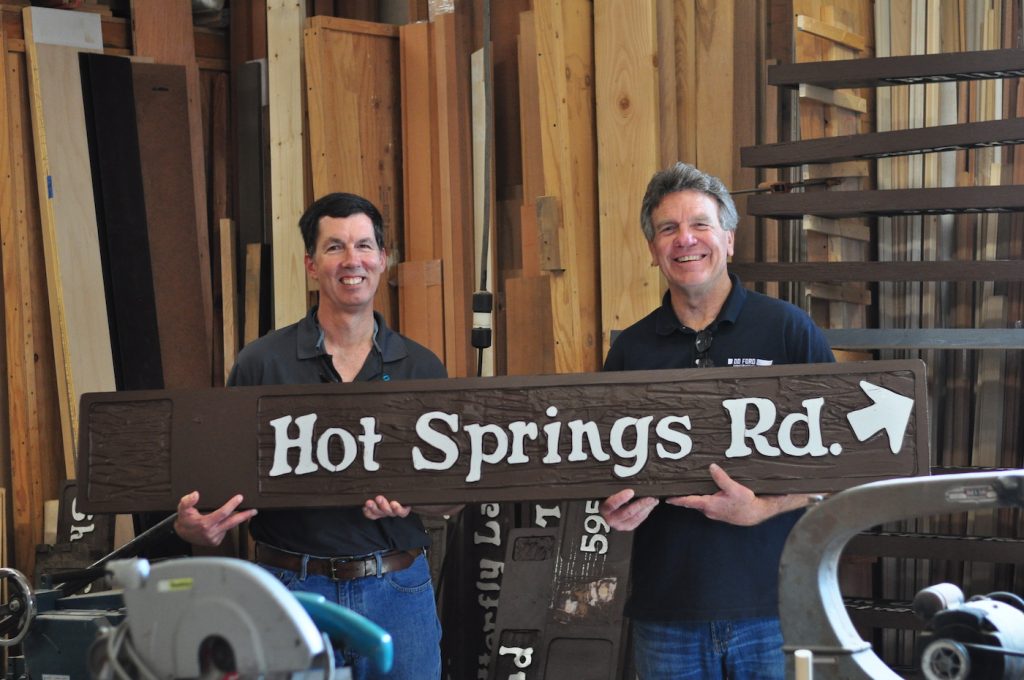
Three Montecito hotels closed temporarily following the mudslide; Montecito Inn, which sustained significant damage to its underground parking garage, the exterior of the hotel, and some interior damage, reopened in the beginning of March, after undergoing a mini transformation with a new exterior marble driveway, new epoxy coating in the valet garage, repairs to the back parking lot, new grand entrance doors, new carpeting, exterior plaster repair, and repainting of the entire exterior including trim and iron work. The Copus brothers, who own the Inn, designed a newly landscaped garden, which includes a planter surrounded by 23 stones, in honor of the 23 lives lost on January 9. In June we saw the reopening of the Four Seasons Resort the Biltmore, which sustained damage to its tennis courts, several garden areas, and the employee/administration building where mudflow caused damage to electrical systems and employee offices. In addition to extensive landscaping work, the resort underwent restoration on a few guest rooms, the tennis courts, the employee and administration areas, areas of the main lobby, and more. Other aspects of the Resort were also revamped, including staff uniforms, all food menus at the Resort and Coral Casino, the spa treatment menu, and the addition of new product lines. The San Ysidro Ranch, which sustained major damage to the grounds and several cottages, is expected to fully reopen in early 2019; the Ranch held a small number of private dining events during the holiday season.

Residents whose homes were severely damaged or destroyed began navigating the rebuilding process shortly after the debris flow. The County assigned case managers to oversee the rebuilding process for each individual homeowner. In May, the County Board of Supervisors unanimously approved a “like-for-like” ordinance amendment allowing property owners to rebuild their homes with the same or substantially the same footprint, height, floor area, and bulk as the structure that existed prior to the disaster (i.e. conforming structures can be within 10% of the previous footprint, height, floor area, and bulk). The ordinance amendments allow displaced property owners to obtain a planning permit exemption or waiver to rebuild their structure in a safer location on their lot to meet Flood Control requirements, and the amendments allow the replaced or restored structure to exceed the height of the destroyed or damaged structure if necessary to comply with the base flood elevation that exists for the lot after the debris flow or other event. All year long, the agendas at the Montecito Board of Architectural Review included multiple properties going through the rebuilding process.
In April we reported on the Montecito Community Foundation’s effort to replace or repair 36 street signs that were damaged in the mudslide. Doug Ford, a contractor and also a board member on the Foundation, volunteered in 2017 to take on the project of maintaining Montecito’s 212 iconic hand-painted street signs, a project that the Foundation has overseen and funded since 1975. Prior to the debris flow, the street signs required replacement due to termites, theft, wood rot, or car accidents. Ford’s plan was to have the signs repaired by students in high school wood shop classes, as he oversees the shop classes offered by Santa Barbara Unified School District. “Once the Thomas Fire and mudslide occurred, I knew the project I had agreed to take on suddenly got much, much larger,” Ford told us at the time. Shortly after the mudslide, Montecito Fire District personnel escorted him through the disaster zone, to survey the damage and take stock of the missing signage. Ford generously offered the labor and use of his workshop to complete the project; Montecito Community Foundation funded the cost of materials. The Montecito Association donated $10,000 to the project.
In May we reported on the opening of Casa Dorinda’s new entrance bridge at the intersection of Olive Mill and Hot Springs Road. The bridge, which arches over Montecito Creek and serves as both the entry and exit to the 48-acre community, marked the completion of the first major milestone in the facility’s most recent expansion project and was a visual sign of rebuilding following the 1/9 debris flow. The property’s historic southern exit bridge, which was significantly damaged in the mudslide, was demolished after County staff in 2016 estimated that the bridge would degrade structurally over the next two decades. To mark the gratitude of Casa Dorinda residents for the harrowing efforts of Montecito Fire Protection District firefighters during the Thomas Fire and subsequent debris flow, a Montecito Fire truck was the first vehicle to cross the bridge at the ribbon cutting ceremony. Additionally, Casa Dorinda announced a $10,000 donation to MFPD. All 300 residents of Casa Dorinda were evacuated following the mudslide.
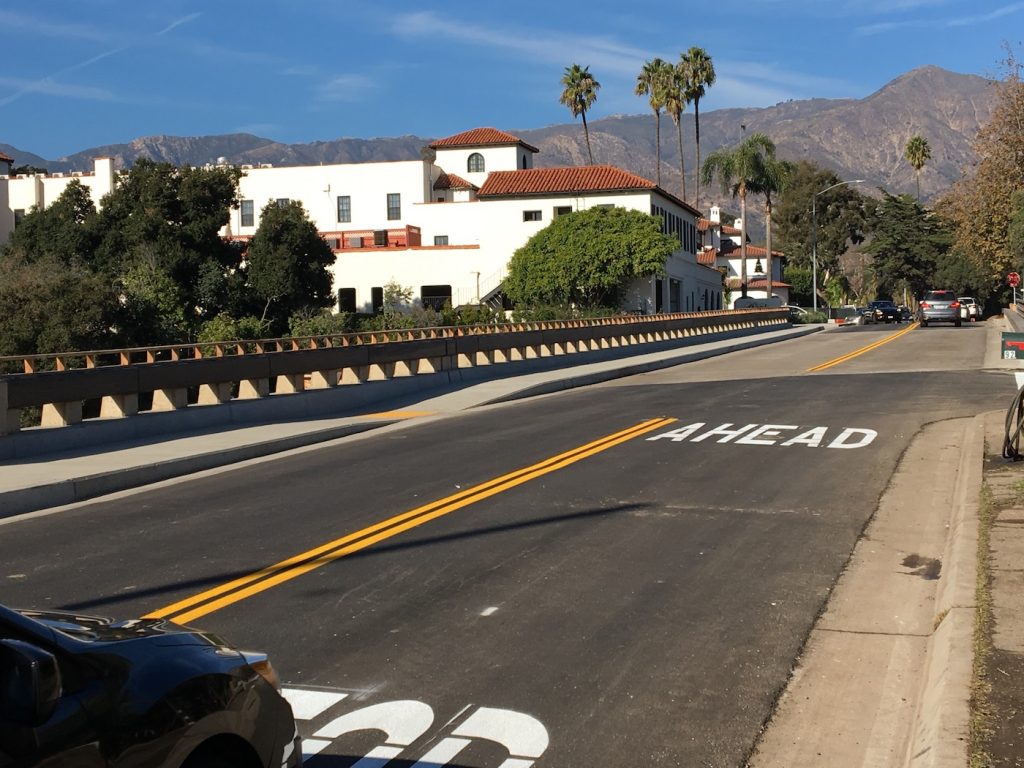
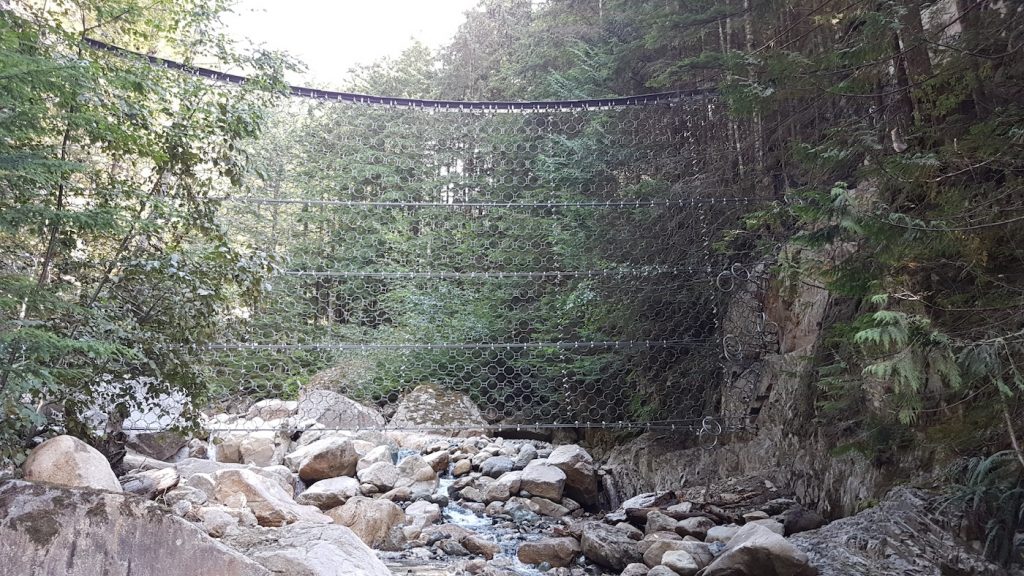
In June, the Board of Supervisors approved the draft of a Strategic Recovery Plan, which outlines the County’s approach to ongoing recovery efforts following the Thomas Fire and 1/9 debris flow. According to Director of Recovery Matt Pontes, the County’s immediate goal is to help the community move forward by bringing together collective resources at the local, state, and federal level. The Strategic Plan includes eight key areas, including Storm Preparation and Evacuation, Long-term Flood Control Mitigation, Private Property Rebuilding, Financial Impacts & Economic Recovery, Removal of Debris on Private Property, Infrastructure Repair and Modifications, Natural and Cultural Resources, and Community Engagement. The plan will assist the County in receiving necessary grants from various entities. Out in the field, we saw the full demolition of the majority of the homes that were beyond repair; this also included clearing properties of hundreds of massive boulders and rocks that came down the foothills on the morning of January 9.
Moving forward, we expect to see the continued rebuilding of private homes, as well as the eventual reopening of the damaged bridges on Highway 192. Seven bridges in Montecito and Carpinteria were damaged during the event; the cost to rebuild and repair them stands at approximately $55 million. All the bridges are expected to be completed early 2019. Nearly half of the budget for the project went to repairing the Olive Mill Bridge at Highway 101, which caused a one-way detour in the area for nearly four months and officially reopened before the holidays.
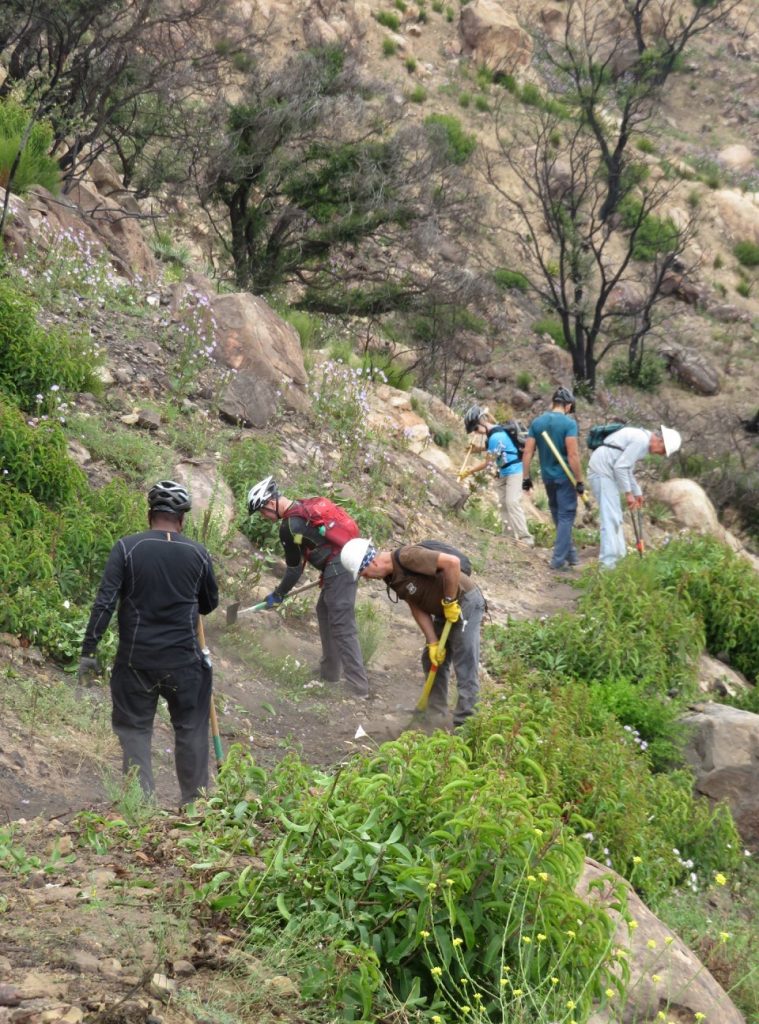
Early on after the disaster, a group of private citizens, dubbed the Partnership For Resilient Communities, quickly realized that the County had a need for expertise and funding, and mobilized various experts to conduct assessments and recommendations about our fragile hillsides. The most feasible and immediate solution, according to the Partnership, is the installation of environmentally friendly Swiss-made steel nets, which catch debris as it comes down the hillsides. The series of nets has the capacity to catch nearly 100 cubic yards of debris; nearly twice the amount of debris that our three Montecito debris basins can accommodate. There are currently 41 such nets in other areas of the state, including Big Sur, Santa Cruz, and Marin. The project, which requires permits from the County of Santa Barbara, the Forest Service, the State Water Board, Army Corps of Engineers, and the California Department of Fish & Wildlife, is in the works, with hope that construction will begin early next year. The group includes Pat McElroy, Brett Matthews, Gwyn Lurie, Joe Cole, Les Firestein, Mary Rose, Ron Pulice, Alixe Mattingly, Cathy Cash, and Hollye Jacobs.
In November, the Board of Supervisors voted unanimously during closed session to begin negotiations with homeowners on Randall Road in hopes of buying seven properties (plus one on East Valley Road) in order to build a new debris basin where the multimillion dollar homes were once located. The short road, which ends at the southern perimeter of La Casa de Maria, suffered catastrophic damage during the 1/9 debris flow when San Ysidro Creek to the east overflowed, killing four people in the immediate area of Randall, East Valley Road, and Glen Oaks, and demolishing over a dozen homes. The County is seeking $19 million in FEMA grant money to purchase the property, agreeing to match $6 million in County funds to make the purchase happen.
The Montecito Trails Foundation spent the year working with Santa Barbara County, Santa Barbara City, and the Los Padres National Forest to restore the trail system in Montecito, which was devastated after the debris flow. The Foundation brought on new board members: Ashlee Mayfield, Paddy McMahon, and Tony Morris, who helped the non-profit to regroup and rebuild the trail system. They join ten other board members, led by Board President Kevin Snow, who has served the MTF for 35 years. In December, the Foundation announced the reopening of portions of the Cold Spring Trail, although other portions still require major restoration. The restoration efforts, which cost upwards of $1.5 million, were sponsored by private donors as well as grants from Montecito Community Foundation and others.
To mark the first anniversary of the 1/9 debris flow, a Remembrance Walk is planned for January 9, 2019. Sponsored by the Debris Flow and Thomas Fire Anniversary Planning Committee, the walk will start at Lower Manning Park with a short program leading into a candlelit processional down San Ysidro Road and ending at All Saints-by-the-Sea Episcopal Church. People will start assembling at Lower Manning Park at 6 pm with a program to begin at 6:30 pm. The walk is estimated to be 15-25 minutes. Shuttles will be available to transport community members to and from Lower Manning Park and other designated sites in Montecito starting at 5:30 pm. The remembrance event will conclude with a bell ceremony and a cup of soup at All Saints-by-the-Sea Episcopal Church, 83 Eucalyptus Lane.
New Maps
In February, Santa Barbara County Office of Emergency Management held both a press conference and a community meeting to unveil a new interactive map and revised evacuation plans for future storms, showing both high risk and extreme risk areas during rainstorms of .5-inch per hour or more; the map was developed by a group of engineers, scientists, and emergency officials. The map was released prior to a significant rainstorm in March; residents and businesses were evacuated but no significant debris flow occurred.
In June, FEMA (Federal Emergency Management Agency) released an updated flood map which stands as the basis on which property owners can rebuild their homes. The map, which is officially called the Interim Flood Advisory Recovery Map, reflects updated flood plains – areas that can be expected to flood in heavy rainfalls– and new elevations that resulted from the events related to the 1/9 debris flow. The map is considered a 100-year flood map, and shows where clear water will flood if debris basins and creek channels are full, during this interim period while our watershed recovers from the Thomas Fire. In order to adhere to flood plain ordinances, homeowners are required to rebuild two feet above the base flood elevation indicated on their property on the map.
The Santa Barbara County Board of Supervisors approved the map the following week, on June 19. Many members of the community did not agree with portions of the map; a community meeting in July addressed these issues and gave residents recourse in pursuing modification of the map. In July, the Montecito Planning Commission and Montecito Board of Architectural Review held a workshop to review the FEMA Interim Flood Advisory Recovery Map, hearing from Flood Control engineering manager Jon Frye, who explained the technical aspects of the map.
Another new map was released in October; this one pertained to debris flow risk and evacuations during significant rainfall. The map removed “mandatory” and “voluntary” evacuation zones and “high risk” and “extreme risk” areas, showing only a red area that would be evacuated during a predicted storm. The map altered the red area by drilling it down to parcels; meaning that an entire property is shown in or out of the risk zone, leaving less room for confusion on whether a homeowner should leave during an evacuation. That map had 2,496 parcels identified in Montecito and Carpinteria that were considered at risk. The interactive map allows users to type in their address, and if their parcel is located in the red zone, it will be very clear that the property is under evacuation. This area was determined in part by the watershed emergency response team, who used Lidar data and topography post-1/9 debris flow to determine where both high energy and low energy debris flow is likely to occur.
At the same time, the County also revised both the evacuation threshold as well as the plan that will be followed during predicted storms. The evacuation threshold was increased from .5-inch of predicted rain per hour to .8-inch of predicted rain per hour. For perspective: the burst of rain that caused the 1/9 debris flow was .54 inches in 5 minutes, which is the equivalent to over 6 inches in an hour.
In December, the October map was further modified, removing 1,187 total parcels (in Montecito and Carpinteria) from the red area, and adding 200 other properties. As of press time, there are 1,149 total parcels in the “red area” in Montecito; a massive door-to-door campaign took place in December to alert each and every homeowner in the evacuation area. During evacuations, several schools in Montecito will close including Montecito Union School, Laguna Blanca Lower School, and Crane Country Day School. Cold Spring School, Mount Carmel, and Westmont will remain open.
For access to all of the relevant maps, visit www.readysbc.org.
Project Progress
YMCA
In October, YMCA reps revealed new renderings for a scaled down and redesigned version of the Master Plan update, which has been in the works for over a decade. The former, more expansive plan, which was submitted to the County in 2013, required that overflow parking be available off-site at Lower Manning Park. However, the Y was unable to secure a long-term parking agreement with the County Parks Commission last year, and instead sought to revise the plans so that all parking could be on the 4.25-acre site. The plans began to shift in February 2017, but were halted late last year following the Thomas Fire and the mudslide. The Y sustained minor damage to the site during the debris flow: the loss of water caused the malfunction of the YMCA’s pool pump.
The new project, which is being called the Revised Master Plan, includes a significant reduction in programing, including eliminating the YMCA’s preschool program, with potential plans to locate it off-site if the need exists. The plans also include a remodeled and slightly expanded main building, which does not include a second story as originally planned. That building will house weight training, cardio, offices, childcare, group fitness, and a flex/meeting room; the group fitness area has been relocated to be further away from the perimeter, in order to assuage neighbor concerns about noise. A new locker room building will be nearly the same size as the current locker rooms, and will include family changing rooms. The new multi-purpose building will be 9,100 sq. ft., and is slated to be tucked in the northwest corner of the site. It will serve to offer a place for basketball, volleyball, and adult wellness classes. The pool will be revamped and widened. The entire new plan is reduced in size by 29% from earlier versions, and is approximately 10,000 sq. ft. larger than the current buildings.
The new plans have lessened the parking requirement to 96 spaces. The second parking lot, which was originally going to be used for staff only, has now been expanded to offer 44 spaces; it is accessed off San Ysidro Road. The main parking lot will house about 56 spaces, and any overflow will still go to Lower Manning Park, where there is an ongoing short-term lease agreement that is re-upped every six months. In order to adhere to Flood Control regulations, the main building and locker room building will be built with a waterproof siding, and include flood barriers that can be placed in front of the doors before a predicted storm.
The design of the plans has also changed; DesignARC architect Mark Kirkhart has revised the formerly modern industrial style buildings to have more of a rustic, modern farmhouse feel. The buildings will have board and batten siding as well as stone façade. The project will be heavily landscaped on the San Ysidro side, to buffer the facility from the street.
The project is still in its conceptual stage, and was seen by the Montecito Association Land Use Committee and Montecito Board of Architectural Review in November.
The Rosewood Miramar Beach Montecito
Construction on Rick Caruso’s Rosewood Miramar Beach Montecito resort began in the late summer of 2016, and continued throughout 2017 and 2018, with an opening expected by the summer of this past year. Complications from weather as well as the Thomas Fire and subsequent mudslide delayed several aspects of construction, with the resort now slated to open February 11, 2019.
The resort will be part of Rosewood Hotel & Resorts’ prestigious collection of luxurious destinations, and includes 124 refined guest rooms and 37 luxury suites located within lanai cottages, garden bungalows, and a classic main house. The property will feature an oceanfront restaurant and bar with an outdoor terrace, a signature restaurant in the main house, two swimming pools, a fitness center, and a wedding/event space accommodating up to 400 guests. The Miramar Beach Club, an exclusive beachfront, private members-only beach club, will open in tandem with the resort and feature an indoor/outdoor lounge, dining venues, beach access, and activities, and a private pool and cabanas. The final project entails 200,000 sq. ft. of development.
The project was in front of the Board of the Montecito Architectural Review at various points throughout the year, including in February and March for architectural revisions to the exteriors of several buildings, in May, June, July, and August for revisions to the landscaping, hardscaping, and lighting plans, and in December for revisions to the signage plan.
Roundabouts
In 2017, we reported extensively on two roundabout projects slated for Montecito; one at the junction of Olive Mill Road and Coast Village Road, and one at the intersection of North Jameson Lane and San Ysidro Road. Both roundabouts are considered parallel projects to the Highway 101 widening project.
In August, a public meeting was held at Chase Palm Park Center for residents to learn more about the roundabouts. Santa Barbara County Association of Governments (SBCAG) has been working closely with staff from both the City of Santa Barbara and County of Santa Barbara to continue progress on these projects, and while the Olive Mill roundabout has been in the works since that time, the new roundabout at San Ysidro Road was only deemed necessary after it was determined that the intersection at San Ysidro and North Jameson fell short on meeting the level of service required by the County. A number of alternatives were considered for both sides of the San Ysidro Road bridge, including roundabouts at both intersections on San Ysidro (one near the Miramar and one at North Jameson), as well as alternatives showing various combinations of all-way stops, traffic lights, and roundabouts. The recommendation of evaluators was a combination of a roundabout at the north intersections and all-way-stop-control at the south intersections. According to County reps, this configuration meets County and Montecito Community Plan level of service requirements, addresses potential backups on the freeway off-ramps, provides continuity to the regional frontage road system with Olive Mill and Coast Village Road, minimizes footprint and impacts, and improves pedestrian and bicycle access through the interchange.
Both roundabouts are in the preliminary design phase with no firm dates on design completion or construction.
Coast Village Road
Several upcoming development projects on Coast Village Road progressed this year.
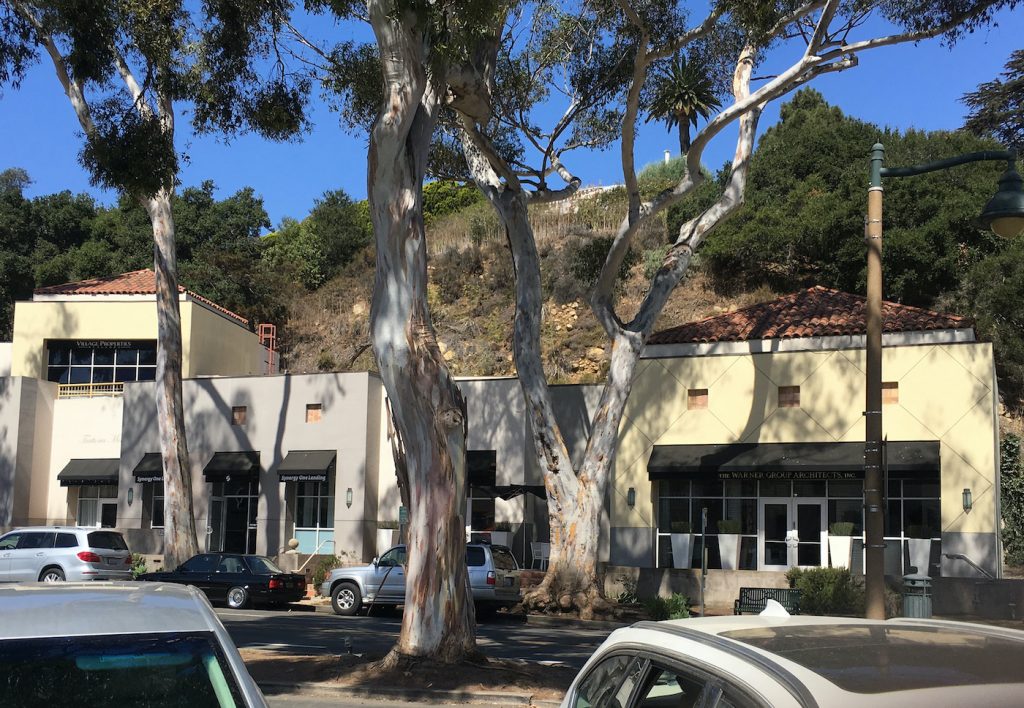
1298 Coast Village Road: The most significant transformation of the year was at the corner of Olive Mill Road and Coast Village, where developer John Price is putting the finishing touches on his long awaited mixed-use building, nearly 15 years after the first application to build there was filed with the City of Santa Barbara. The project consisted of the demolition of the existing gas station and service bays, followed by the construction of a new three-story, mixed-use building with 4,800 sq. ft. of commercial space on the ground floor and 13,795 square feet of residential space on the second and third floors. The residential component includes two three-bedroom units, and three two-bedroom units. The project also includes a subterranean parking garage, which was mildly impacted by the 1/9 debris flow.
We expect to see the opening of the building early in 2019; the commercial spaces will be filled by real estate company Village Properties, art gallery Heather James, and a wine tasting room by Folded Hills.
1062 Coast Village Road: In May, the Santa Barbara City Planning Commission unanimously approved a new condominium project slated for 1062 Coast Village Road, which includes nine two-story residential condominium units, one commercial condominium unit, and a subterranean garage with 23 parking spaces.
The project is to be located on the property between Starbucks and China Palace; property owners David Back and Monika Draggoo plan to demolish the 10,000-sq.-ft. apartment building, carport, and hardscape, as well as remove seven mature canary island pine trees, and one gold medallion tree. The new project includes a stone façade commercial building facing Coast Village Road, as well as a subterranean garage with six commercial parking spaces and one commercial bicycle space. It also includes nine residential condominiums housed in five separate buildings, including private subterranean two-car garages that include private elevators into the units. The average 2,400-sq.-ft. three-bedroom condos include living space on the ground floor, bedrooms on the second floor, and rooftop decks.
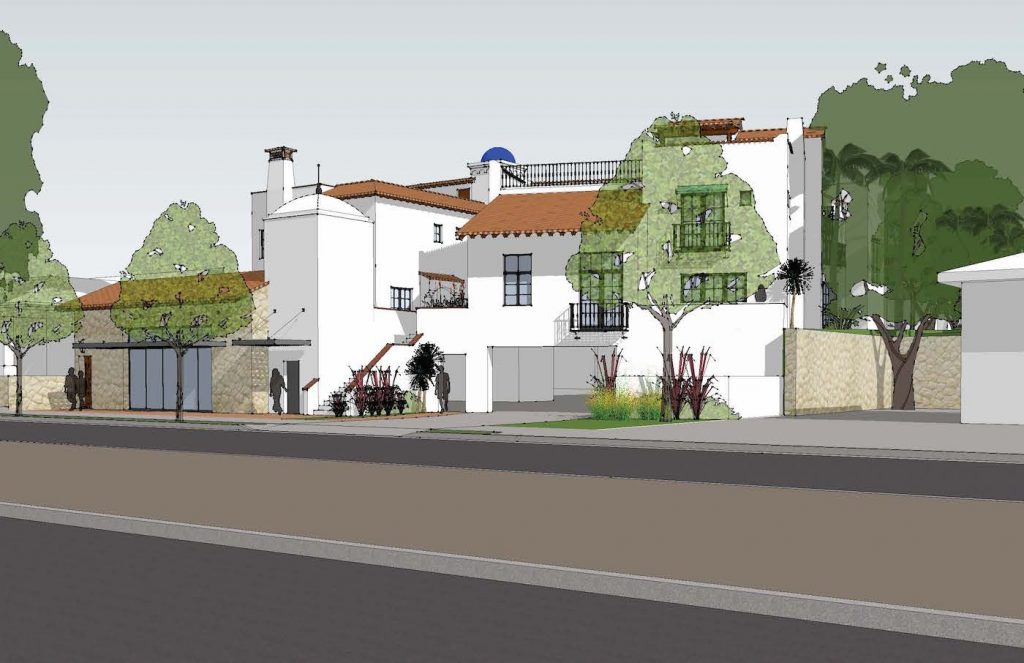
Architect Brian Cearnal, who also designed the Plaza Montecito building and two condos on the former property of Turk Hessellund Nursery, presented the project to various Montecito and Santa Barbara entities, including the Land Use Committee of the Montecito Association, both the Montecito Board of Architectural and Santa Barbara Architectural Review Board, the Montecito Planning Commission (for courtesy review), and the Coast Village Association. The project was revised to mitigate several issues, including neighborhood privacy issues concerning noise and lighting on roof decks, and the removal of onsite trees. Neighbor concerns were addressed by adjusting the parapets on the rooftop decks, eliminating two “Juliet” balconies, and frosting the stairway windows. The tree concerns were also mitigated: the initial proposal included the removal of all onsite trees; now, a greater setback is eliminating the need to remove so many trees, and 42 trees will be planted.
The Planning Commission voted unanimously to approve the project as well as two modifications including an interior setback modification and a modification that would allow for lesser distance between the buildings, both of which City staff conclude are minor and have a negligible impact. The project’s design was further reviewed and approved by the Architectural Board of Review in September. Once ground is broken, it’s expected the development will take 16 months to complete.
1250 Coast Village Road: Just last week we reported on the proposed revitalization of one of Coast Village Road’s most iconic buildings, which is home to Village Properties, Riskin Partners, Synergy Lending, and the Warner Group Architects. The Warner Group, which has been a tenant in the building for 20 years, is designing the remodeling project, which architect Thiep Cung calls a “complete facelift.” The project plans include a completely revamped exterior façade of the 1991 building, including a new paint job and color scheme with warm grey tones, new exterior tile floors in a porcelain herringbone pattern, remodeled roof to a more contemporary patina standing seam roof, replacement of the awnings, and a new landscape plan. The project will also bring the bathrooms up to ADA compliance, as well as replace the elevator, widen the ramps, and add ADA van parking in the downstairs parking lot.
The plans for the remodel were in front of the City’s Architectural Board of Review in December, and will be back for more conceptual review in January 2019.
Short-Term Rentals
The grace period to operate Short Term Rentals (STRs) ended on October 1, 2018. In 2017, the County Board of Supervisors adopted ordinances which prohibit STRs in inland residential zones, with the exception of “homestays.” The homestay portion of the ordinance language was in direct response to community members who voiced concern over not being able to supplement their income with short-term rental income. The County has allocated funds for the regulation of homestays, but it’s unclear at this point what that will look like. The County gave vacation rental owners a year grace period before beginning regulation.
Still up for discussion is how STRs should be regulated in the Coastal Zone. In May, the California Coastal Commission denied the BOS’ ordinance amendments pertaining to the prohibition of STRs. The BOS proposed that STRs would also be allowed in commercial zones as well as a new overlay (dubbed the Coastal Zone Historic Overlay Zone), located in Montecito. That overlay spanned from South Jameson Lane to the beach, between part of Danielson Road and Posilipo Lane. Roads including Edgecliff Lane, Miramar Beach, Humphrey Road, and Eucalyptus Lane were included in the small overlay district. The Coastal Commission denied the ban, citing too few overnight accommodations for coastal visitors, and extremely high demand for the County’s campground units.
In response to the Coastal Commission hearing, the BOS directed staff to formulate ordinance amendment language that will allow the grandfathering in of STRs anywhere in the Coastal Zone; owners must show they’ve been paying Transient Occupancy Tax (TOT) for the last five years. If an STR owner sells their home, the right to continue to short-term rent would be extinguished with the sale. Owners would also have to renew their business license every year, and be subject to regulations.
Accessory Dwelling Units
In September, amendments to the County Land Use and Development Code, Montecito Land Use and Development Code, and the Coastal Zoning Ordinance to revise existing development standards for Accessory Dwelling Units (ADUs) went into effect; the amendments were approved by the Santa Barbara County Board of Supervisors in August. Because the County had yet to pass its own ordinance language regarding ADUs, Montecito and other unincorporated areas had been governed by the state-mandated ADU laws, which went into effect January 1, 2017.
California Assembly Bill 2299 and Senate Bill 1069 set out to reduce the barriers that homeowners once had when trying to gain approvals for these “granny units,” expanding the capacity to accommodate their development in order to provide additional rental housing in residential areas throughout California. Since the passing of the State laws, there have been 160 ADU applications in the County, with over 60 approved in Montecito. A streamlined process has been developed at the County level, with ADUs to be approved ministerially without discretionary review if they meet certain standards. If an ADU is located within an already existing portion of a single-family or multi-family dwelling or accessory building, and has an independent exterior entrance and is within the size limits, it will be exempt from requiring a land use permit. These ADUs will not be subject to parking standards. If an ADU is partially within an existing building or a new addition or separate building is being built for it, the ADU must comply with design, height, size, and parking requirements, and the Planning Director may request review of the project from the Chair of Montecito Board of Architectural Review or the Historic Landmarks Advisory Commission (HLAC). All ADUs will be required to show approvals from the local sanitary district or show approved onsite wastewater treatment systems.
Earlier this year, draft ordinance language was circulated to both the Santa Barbara County Planning Commission and Montecito Planning Commission, who both gave recommendations of added language. Staff removed several of those recommendations, including lot coverage, the requirement that a homeowner must live in one of the dwellings, and site preparation standards. Staff did revise the language to allow for parking lifts if additional parking is required. It was also clarified that ADUs cannot be rented out short term (fewer than 30 days) or be sold separately from the principle dwelling. Detached ADUs will also be regulated in location and size; the maximum size of an ADU is 8% of the net lot area, up to 1,200 sq. ft.
The County may soon need to revise the newly-passed ordinance language, as the State is currently revising its requirements via AB 2890, which prohibits standards for lot size or lot coverage, shortens application review from 120 to 60 days, and increases the minimum size of ADUs from 150 sq. ft. to 800 sq. ft. If approved, the law will also expand the types of ADUs that are exempt from planning permits, and will allow multiple ADUs on a qualifying lot.
School Happenings
In 2017, we noted the hiring of two new school superintendents in Montecito: Anthony Ranii was hired at Montecito Union School, and Dr. Amy Alzina took the reigns at Cold Spring School. Both superintendents, as well as school leaders on every campus in Montecito, were put to the test this year.
Montecito Union School

In February, the MUS board of trustees held a special meeting to discuss several issues related to the mudslide including its effect on the school’s finances, enrollment, and facility. Because of the school’s basic aid status, its revenue was impacted when reassessments of property values were conducted after the mudslide. The school is expected to lose $1.6 million in revenues. The school’s enrollment decreased as well, as many families moved out of the district. It was determined that the school would need to cut several teachers and staff members to account for the new budget cuts. The board also decided to allow students not living in the district a grace period until the end of the 2018/19 school year to attend MUS; 24 families with 32 students are taking advantage of the grace period.
The campus was a hub for many community meetings, forums, and special events related to the mudslide. Ranii even donated space to the Bucket Brigade, allowing the group to store equipment at a locked facility on the site. Several boulders and rocks left over from the debris flow were also temporarily stored on a portion of the campus.
The school board continues to work on plans for upgrading the campus facilities, and it is expected that necessary facilities improvements will be done with in-house funds instead of a tax bond. In December longtime board president Gwyn Lurie retired from her position on the board, after eight years of service. The vacancy left by Lurie will be filled by Susannah Osley, who will join board members Chad Chase, Kate Murphy, Peter van Duinwyk, and Marilyn Bachman.
Cold Spring School
Dr. Alzina dealt with similar issues on the Cold Spring School campus, adding to the morose reality that two students from Cold Spring School were killed in the mudslide. CSS faced a $485,000 budget shortfall due to the mudslides, and started a fundraising campaign to close the gap. In September, Dr. Alzina announced the school had received a $300,000 grant to help pay for key staff members and a counseling program.
In May a memorial bench was installed near the playground in memory of the two Cold Spring students lost in the mudslide: six-year-old Peerawat “Pasta” Sutthithepa and 12-year-old Sawyer Corey. The bench was created by a local member of the community, out of a fallen sycamore tree that fell during the debris flow.
Crane Country Day School
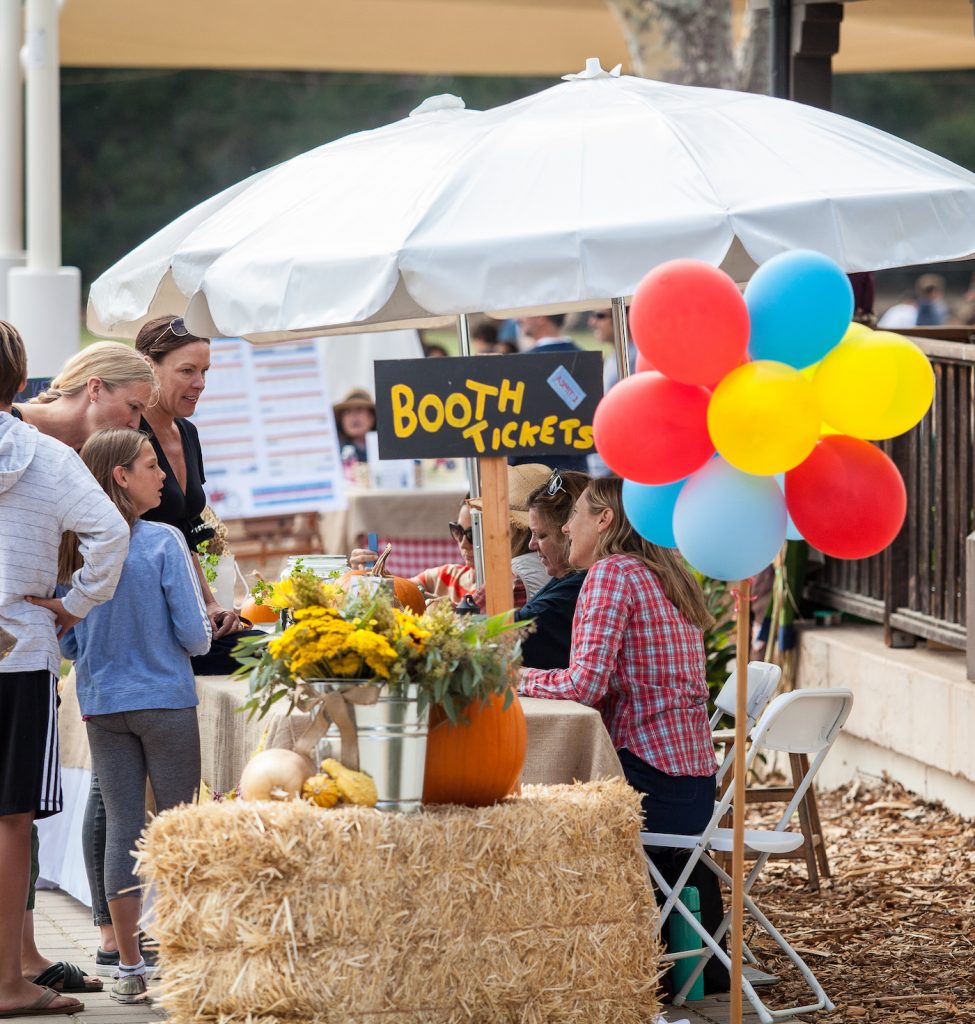
The Crane campus on San Leandro Lane was opened as a base for firefighters and rescue personnel who came to help search for victims in the first few days of the mudslide aftermath. The students, after being taught at four satellite locations, returned to the campus in early February.
In March, the school hosted the first ever Respond-A-Thon and Spirit Day, raising funds to benefit the Santa Barbara County Animal Services, the Santa Barbara Bucket Brigade, Direct Relief International, Santa Barbara County Search and Rescue, and the Unity Shoppe.
In September, the Crane campus was used to host Montecito Trails Foundation’s annual BBQ. The BBQ was an opportunity to thank MTF supporters and trail enthusiasts. In lieu of the usual silent auction, the BBQ was a time for community celebration with a raffle, food, and an emphasis on the trails.
The Crane Country Fair went off without a hitch in October, bringing a carnival-like atmosphere to the campus for a day of fun, food, games, and community.
Next year the school will mark its 90th anniversary with an array of celebratory events.
Hellos & Goodbyes
Our local business districts welcomed new businesses and said goodbye to several others this year.
In April we saw the opening of Frankland’s Crab & Co. at Montecito Inn. Chef-owners Phillip Frankland Lee and Margarita Kallas-Lee opened the casual seafood shack where Montecito Café’s bar area once was, to the left of the main driveway. The eatery offered local seafood like ridgeback shrimp, wild-caught crab, and clams and oysters, fish & chips, chowder and more. Four months later, the owners reinvented the concept, deciding instead to turn it into Chaplin’s, a sleek lounge serving cocktails that were popular in the roaring twenties. “We heard the community loud and clear,” said Frankland Lee.


In August, Frankland Lee and Kallas-Lee also opened The Monarch, the duo’s hyper-local all-day dining room and bar in the space formerly occupied by Montecito Café. The much anticipated restaurant centers around a collection of the season’s best vegetables, fruits, herbs, seafood, and meats – cooked over a wood-burning hearth and paired with regional wines, and served in a warm, friendly atmosphere. The menu at The Monarch sources ingredients locally from the Central Coast, with the majority coming from within the borders of Santa Barbara County. The offerings include an array of appetizers, family-style entrees, warm, freshly baked bread with house-made butter, and dessert by Kallas-Lee.

In April we saw the closing of Blanka, an eclectic boutique by Jennie Reiter, who decided to close the store after a hard few months of business brought on by the Thomas Fire and debris flow. The boutique changed hands to Kannyn January, who turned the space into Ambiance, which has a similar feel and offering to Blanka. In the same building, we saw the closure of Red Studio, a Coast Village Road salon staple for 28 years. The salon closed following the extended evacuations following the 1/9 debris flow. In its place, real estate brokerage Compass opened a second CVR location there in October. The new office, located at 1270-1272 Coast Village Road, is separated into two offices on either side of the breezeway; one side houses the Morehart Group and the other is a collaborative office space with five individual desks as well as a well-stocked kitchen. Next door, Leggiadro Boutique, which offered Italian made clothing and fabrics, closed its doors in December. That space is currently for lease.
In July we saw the departure of Dance Fever Studio from Coast Village Walk, and in August Antoinette Boutique moved into the space, after occupying a nearby space in the Walk for 43 years!
Coast Village Plaza at 1187 Coast Village Road welcomed two new tenants this year. Renaud’s Patisserie & Bistro opened in August, with owner Renaud Gonthier bringing his “taste of Paris” to Montecito. The space was transformed to resemble a chic, French-style bistro, with dark colors, brass fixtures, marble tabletops, exposed piping, contemporary tile floors, and pops of muted red. The menu is nearly identical to the other Renaud’s locations, with specialty egg dishes, baked goods, French toast, yogurt, oatmeal, and more for breakfast, and an array of salads, sandwiches, French onion soup, and mini raviolis for lunch, as well as the usual sweet and savory baked items Renaud’s is famous for.


In November we welcomed Khao Kaeng, the newest concept from the owners behind the widely popular Empty Bowl Gourmet Noodle Bar at the Santa Barbara Public Market. Co-owners Jerry Lee, Emre Balli, and Nui Pannak bring their elevated Thai cuisine to Coast Village, with scratch-made everything including the house-made curry and chuchi pastes, stir-fry sauce, peanut sauce, and more. The aesthetic at Khao Kaeng – which is translated to mean “curry on rice” in Thai – is contemporary and chic, and includes Asian art and artifacts from Lee’s travels. The stone wear serving dishes and plates are all artisan made, curated to showcase the food, and golden silverware featuring the image of the Buddha was imported from Thailand. A partially exposed wine cellar near the bar boasts an array of handpicked selections, some of which are not offered by any other restaurants.
Next year we can expect the closing of Giovanni’s after over three decades; Ca Dario is slated to move in to that space. Next door, Here’s the Scoop owners Ellie and Bob Patterson are looking for someone to take over the thriving gelato and sorbet business that they’ve had for over 14 years. The Pattersons say their ideal buyer is someone who wants to become entrenched in the community, and carry on the traditions of the shop, including the costume contest the Pattersons host each year on Halloween, and the wall of kids’ pictures.


October marked the opening of Bettina in Montecito Country Mart. Husband and wife team, Brendan Smith and Rachel Greenspan,have brought their Neapolitan-style pizza to Montecito, along with simple salads and small plates; a menu Greenspan describes as “California cuisine with an Italian accent.” The beautifully remodeled 2000-sq-ft restaurant, once the home of Tsunami, was designed with the help of Los Angeles based designer and architect, Barbara Bestor, and seats about 40 patrons with a mix of leather booths, tables, and bar seating. Five counter seats overlook the open kitchen, allowing diners to watch Smith and his team man the 850-degree Italian pizza oven, which cools to 550 degrees by the morning, and is the perfect temperature to bake loaves of homemade bread used for other menu items. The restaurant also has a full liquor license, with a mix of new and old-world wines, the majority of which are organic, biodynamic, or natural.
In 2019 we expect the Mart to welcome Caffe Luxxe – an artisanal espresso and coffee shop – and Merci Montecito, the newest iteration of Merci To Go, which had a space at the Mart a few years back.


In October, we marked the opened of Synergy Lending, a recently acquired subsidiary of Mutual of Omaha that opened in the former home of Shine Blow Dry Bar at 1250 Coast Village Road. The nationwide mortgage lending company, which is based out of San Diego, was founded by Westmont grad Torrey Larson. The associates at the new Coast Village Road office include Jasun Carter, Scott Bradley, Jovan Obando, and Tom Kronen.

In December, Carole and Mike Ridding, owners of Silverhorn, opened a smaller design studio at 1235 Coast Village Road, a year after closing their larger store at 1155 Coast Village after 30 years in business. 2018 also marked the fifth anniversary for Allora by Laura and the 17th anniversary for Montecito Deli, and we saw revamps to Viva Oliva and Bree’Osh, while The Gallery Montecito closed its doors in July after three years in business.
In the upper village, business owners were evacuated for several weeks in January following the debris flow. After reopening, it took many weeks for shoppers and diners to return to the business district, as many Montecito residents remained displaced. Despite the loss of business, the majority of shops in the upper village remain in business, and a few celebrated significant anniversaries. Skin Essentials next to Pane e Vino celebrated 20 years in business in July; owner Julie Phillips has had her current space since 2000, offering facials, microdermabrasion, lymphatic treatments, peels, permanent makeup, body exfoliation, waxing, and more. Phillips attributes her success to repeat clients and referrals, and celebrated the anniversary with an open house for clients and neighbors.
We said goodbye to Brostrom’s Antiques, which closed its doors after over twenty years in business. Known for hand selected Asian antique, vintage, and handmade furniture, the store, owned by Allan Brostrom, was an upper village mainstay with a prominent location on San Ysidro Road. In August we bid adieu to Giuliana Meta, who sold her upper village shop to a new owner, who is carrying on the tradition of the haute couture offerings of the boutique. Her husband George Meta, of Meta Jewelers, also retired.
Montecito Milestones
Montecito Association Happenings
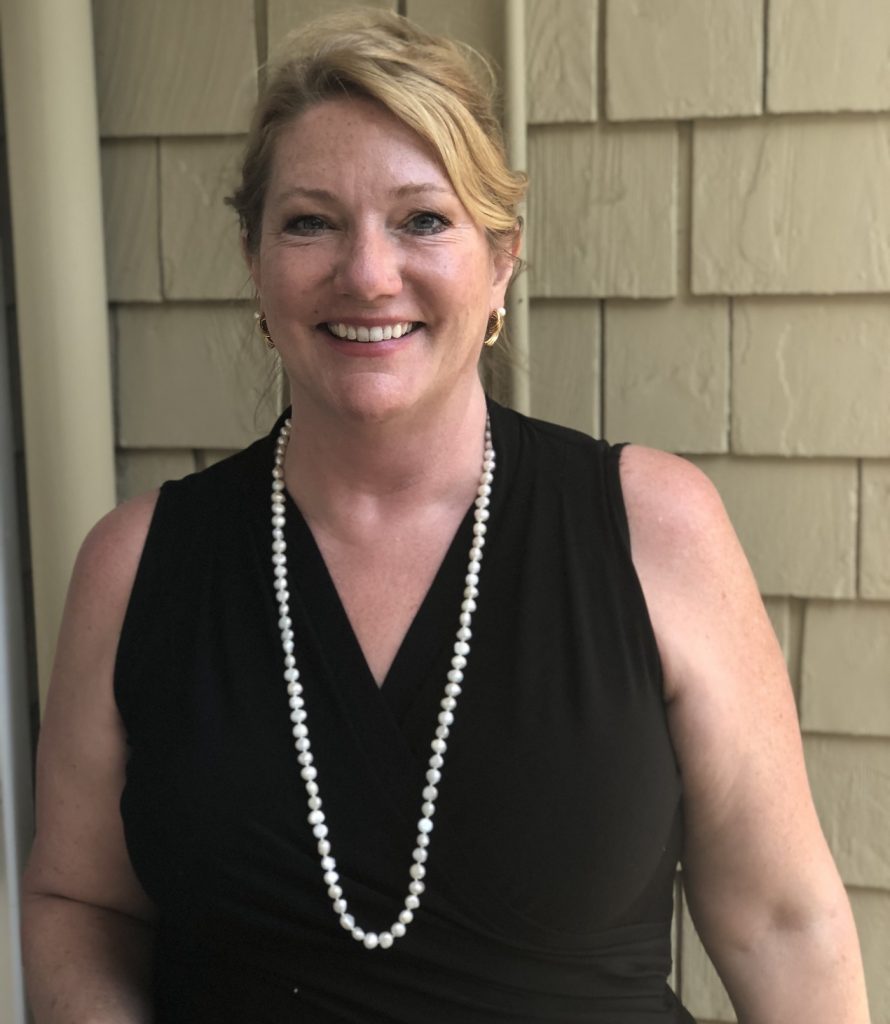
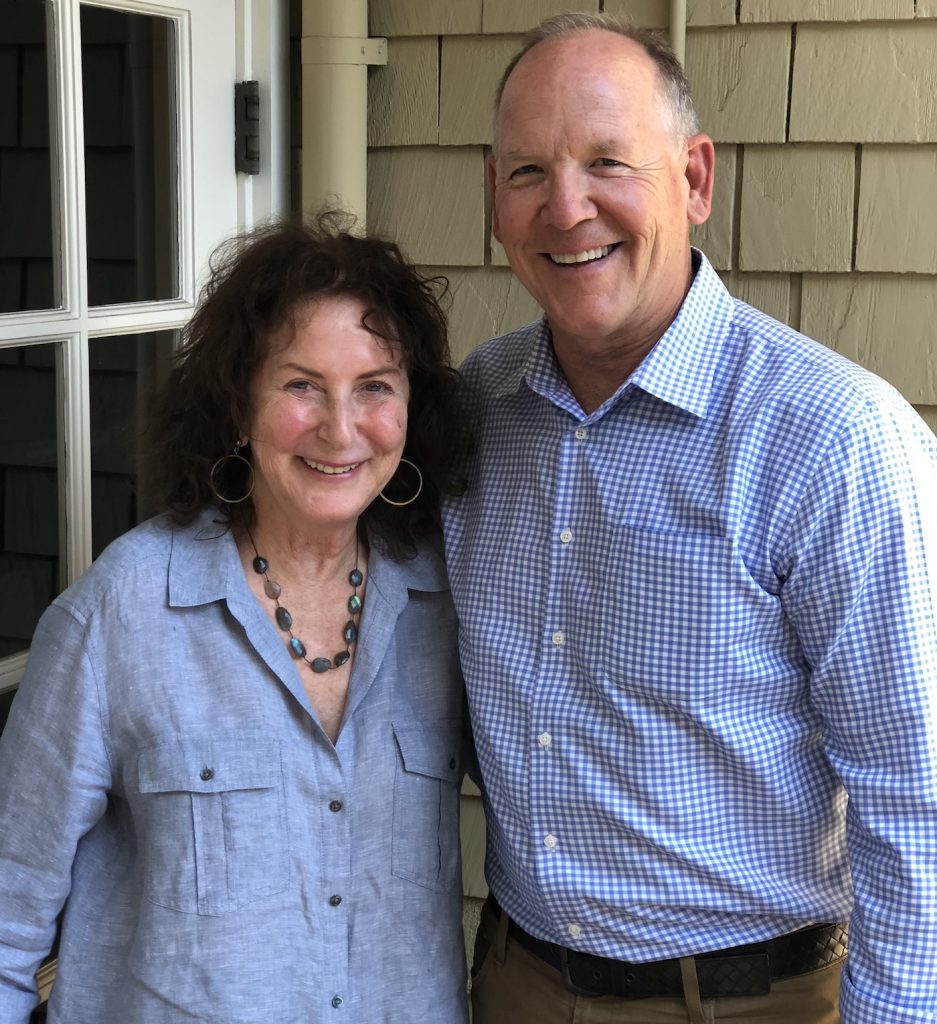
The annual meeting of the Montecito Association was pushed back a month in 2018, due to the cancelation of the scheduled meeting on January 9.
The annual meeting marked the departure of board members Monica Babich, Aaron Budgor, and Laura Bridley, and welcomed two new board members: Linnea Pattillo and Larry Waldinger.
The executive committee was voted on unanimously, naming Charlene Nagel as president, Harry Kolb as first vice president, Peter van Duinwyk as second vice president, Dr. Barbara Mathews as secretary, and Michele Saltoun as treasurer. The February meeting hosted reps from the County including Office of Emergency Management Director Rob Lewin, First District Supervisor Das Williams, and Director of Recovery Matt Pontes, all of whomspoke on the recovery efforts. Much of the beginning of the year the Association board of directors, as well as the Land Use Committee, heard updates on recovery and rebuilding from various entities in Montecito, including the Bucket Brigade, the Montecito Trails Foundation, the school superintendents, the Partnership for Resilient Communities, Montecito Sanitary and Water Districts, and County representatives.
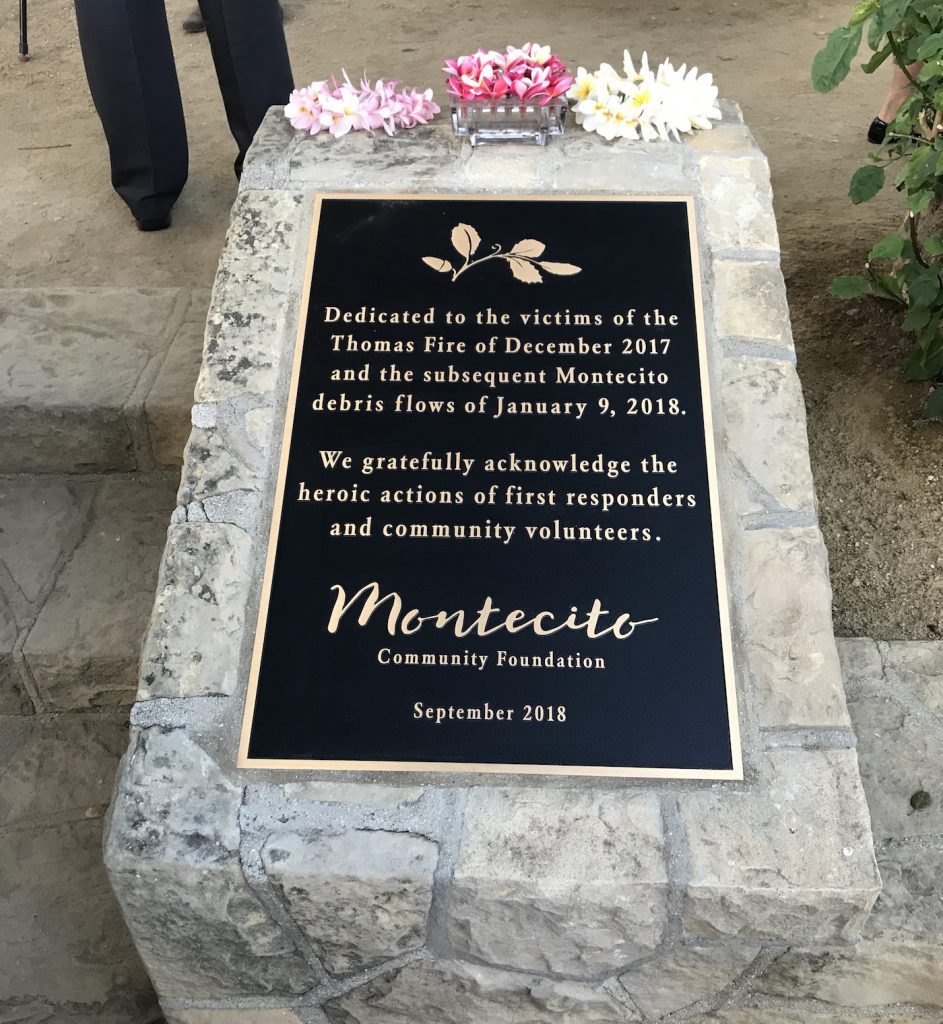
In August, the Association welcomed some new faces, as executive director Allison Marcillac resigned in order to focus her time on navigating the rebuilding process after losing her home in the 1/9 debris flow. New executive director Sharon Byrne joined the Association after her most recent role as the executive director of the Coast Village Association. Two new board members were also voted in: Sandy Stahl and Robert Kemp, both longtime Montecito residents and local realtors, who are heavily involved in the community.
The MA hosted and planned a plethora of community events this year. In July, the MA held its popular Village Fourth parade and bbq, drawing out thousands of people to watch over 100 first responders walk in the parade. In September the group hosted a forum on governance for approximately 50 local residents and stakeholders who came out to listen to Paul Hood, executive officer of the Local Agency Formation Commission, and Dave Mulinex, regional public affairs manager for the League of California, discuss governance options for Montecito.
Also in September, the MA, in collaboration with the Montecito Community Foundation, held an event to unveil a plaque in the upper village, dedicated to the victims of the disaster. Nearly 100 people gathered at the corner green to hear All Saints-by-the-Sea Rev. Aimée Eyer-Delevett, who spoke about her experience on the morning of January 9, 2018, before unveiling the plaque.
In October, the Association co-hosted a Storm Readiness meeting at Montecito Union School, unveiling the newest evacuation maps and the County’s new Ready, Set, Go, emergency action plan, which outlines specific actions to take place in the days leading up to a predicted storm. The meeting also touched on the multiple ways the County plans on notifying the public during emergencies.


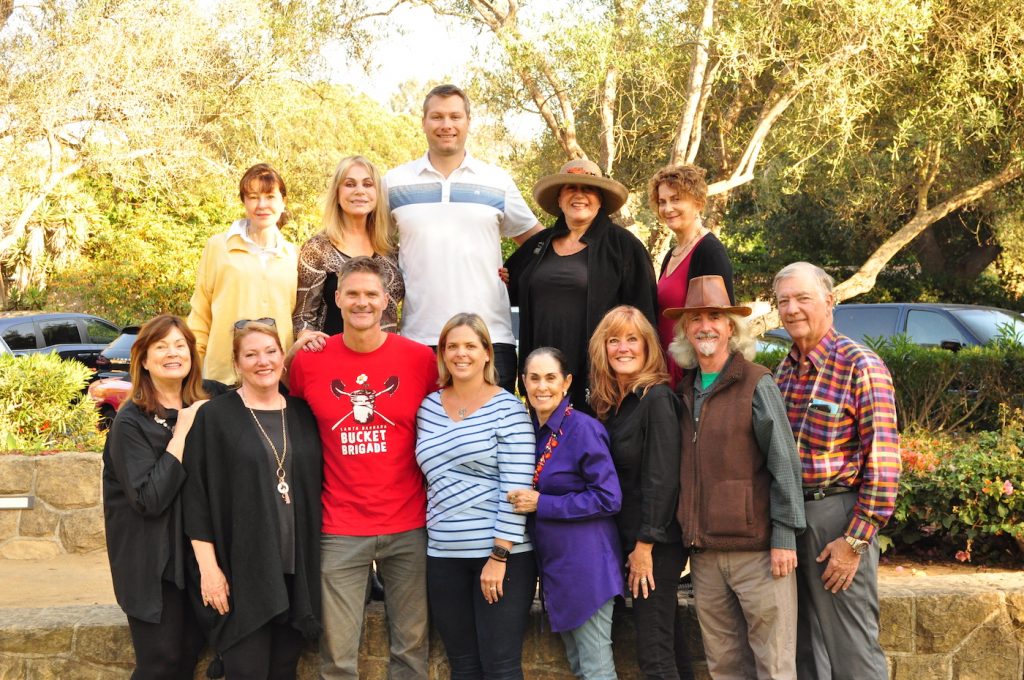
November marked the 33rd annual Beautification Day, where over 100 members of the community turned out to help the Bucket Brigade beautify several areas of Montecito. With breakfast sponsored by the Rosewood Miramar Resort, lunch donated by Montecito Village Grocery and San Ysidro Ranch (and prepared by Montecito firefighters), the event was a collaborative effort, and multiple groups came out to man tables and provide community information, including the Montecito Sanitary District, Montecito Water District, MERRAG, Montecito Trails Foundation, the Montecito Library, and others. Bucket Brigade co-founder Abe Powell was honored as Citizen of the Year.
In December, the MA hosted an inaugural Holiday Magic in Montecito Village event, offering family friendly fun and activities, with upper village merchants offering special treats and shopping incentives. The idea for the event came to fruition following the January mudslide, when shop owners in the upper village were evacuated for several weeks when the area became a disaster exclusion zone. “It became obvious that many of these business owners didn’t know each other well and we needed to unite,” said organizer Sandy Stahl, whose office is next to the post office. Stahl organized the merchants via a newly formed group called the Montecito Village Merchants Organization. Montecito Association Outreach Chair Megan Orloff helped plan the event with committee members Stahl, Robert Kemp, Laura Bridley, Kathi King, Houghton Hyatt, Jean von Wittenberg, and MA executive director Sharon Byrne.
Coast Village Association Happenings
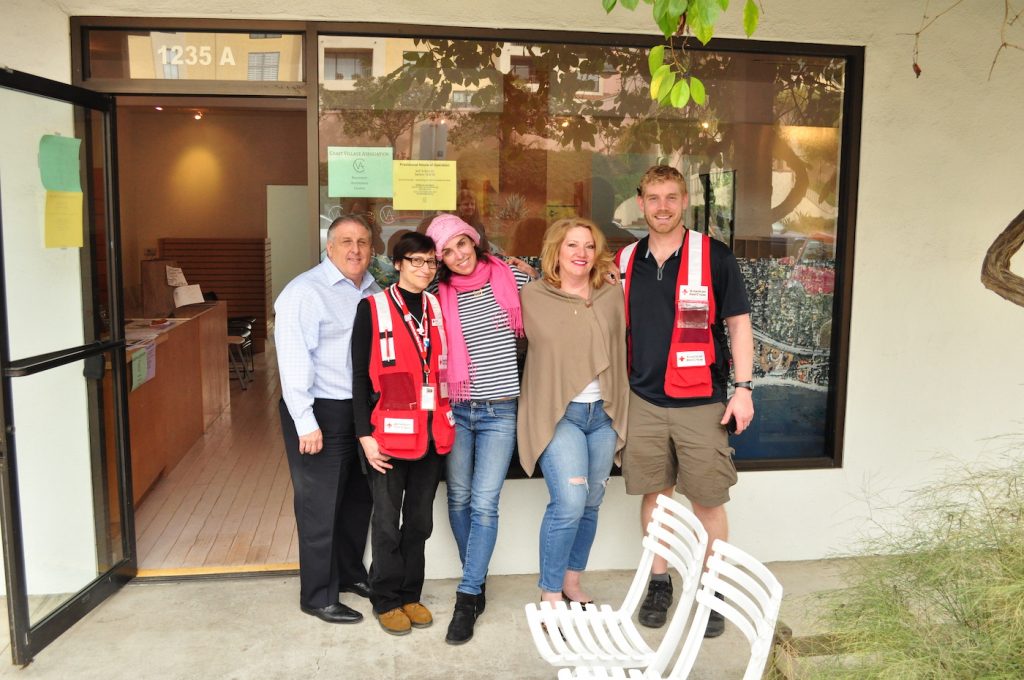
The Coast Village Association was also very active this year, helping business owners navigate their way back to their shuttered stores following the fire and debris flow. While Highway 101 remained closed for nearly two weeks, Coast Village Road became a thoroughfare for an incredible number of trucks and emergency personnel. Following the disaster, the CVA opened a temporary Recovery Assistance Center as a hub for the American Red Cross and other disaster volunteers.

Traffic was a significant initiative taken on by the CVA in 2018: the Traffic & Safety Committee, chaired by Thorn Robertson, spearheaded a project to install temporary stop signs on Coast Village Road at both ends of Coast Village Circle, which will soon be permanent. The now four-way stop at Butterfly/Coast Village Circle/Coast Village Road needs some revision, as the location of the stop sign on Coast Village Road traveling west bound is not as prominent as City reps would like to see. Once a plan is finalized, the stop signs will be made permanent on both ends of the street, along with two new stop signs that have been installed within the parking aisles. The crosswalk that spans midblock between Villa Fontana and the former Silverhorn building will soon have a lighted, flashing crosswalk signal. The committee is also helping the City to make the k-rail speed deterrents in the parking aisles permanent; they will be replaced with more aesthetically pleasing planter boxes containing fruit trees. The planter boxes will be movable, so they can be used as barricades during special events on the street. There is also discussion about revamping the current speed bumps in the parking aisle, and potentially adding more.
The CVA’s Events Committee put on several events to bring awareness to the street and its merchants, including helping host a viewing party for the Amgen Tour, a shopping Spring Fling in April, a fashion event in November, and a special holiday tree lighting in December. Emceed by CVA board president Bob Ludwick, the inaugural tree lighting featured student singers from the local elementary schools, a visit from Santa, and cookies donated by the Four Seasons Resort the Biltmore.
The CVA is currently in the planning stages of a large-scale food-tasting event, the Taste of Coast Village, scheduled for May 2019.
Special Districts
Montecito Fire Protection District
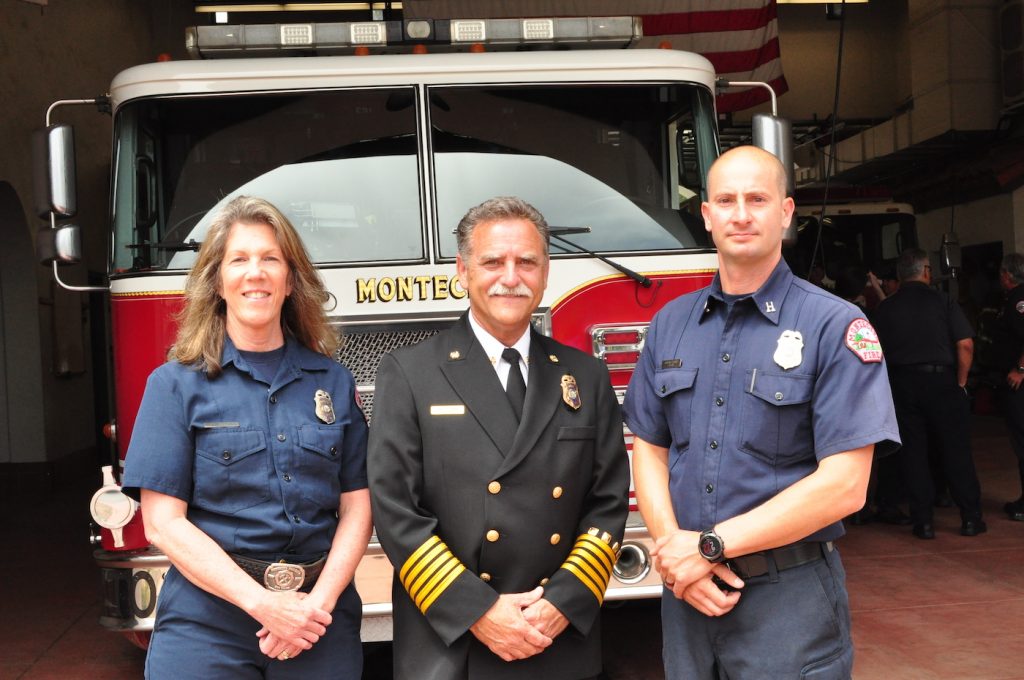
Montecito Fire Chief Chip Hickman started out the year singing the praises of his department during the Thomas Fire, and again for their efforts in saving lives during and after the mudslide. Chief of Operations, Kevin Taylor, was an integral part of the teams assembled to discuss recovery and preparation for future disasters. MFPD is set to incur a 13% loss in revenues because of property tax reassessment following the debris flow; it cost the District $11 million to fight the fire and subsequent mudflow.
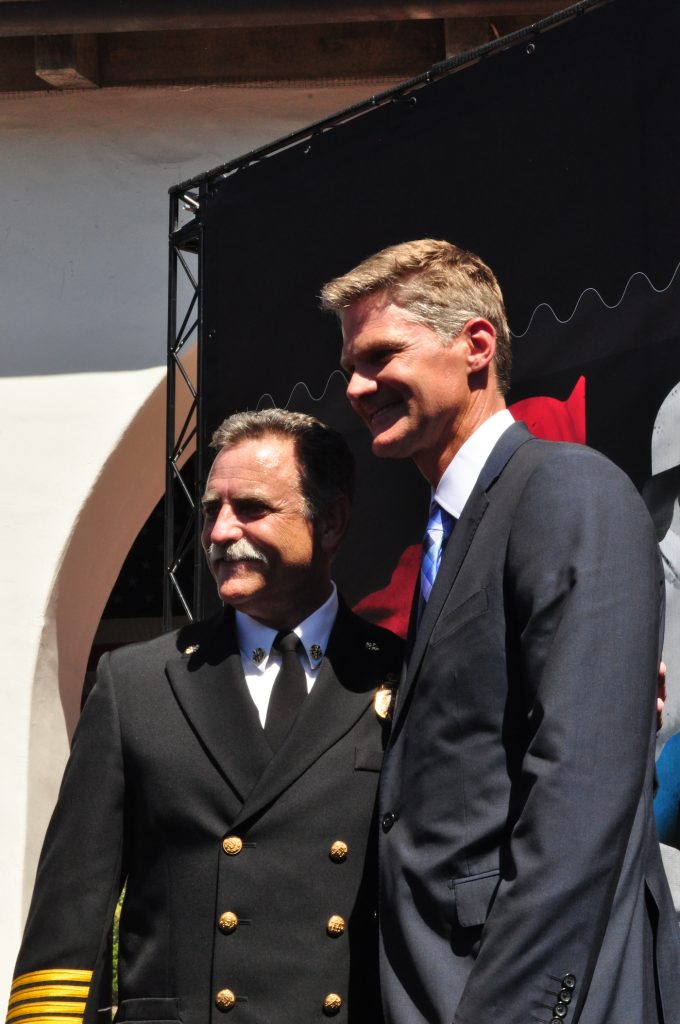
In May, the Montecito Fire Protection District Board of Directors recognized every one of its employees for their performance during the Thomas Fire and mudflow. The firefighters and support staff, who helped navigate the successful rescue of over 800 community members following the mudflow event, were on-duty nearly continuously for 90 days during the fire and mudslide. There were also recognitions to Communications Coordinator Jackie Jenkins, who marked 20 years of service with the District in January, and Engineer Jordan Zeitsoff, who marked 10 years of service with the District.
Over the summer, firefighters from the District were dispatched to other areas throughout the state to help battle wildfires, and in September, the District hosted a special ceremony at Fire Station 1 when the United States Postal Service unveiled a commemorative Forever Stamp that honors first responders. USPS district manager Alfred Santos told the large crowd that he was moved to host the unveiling in Montecito, following the Thomas Fire and January mudslides, and the exceptional work of first responders in our community. Following the singing of “God Bless America” by mudslide survivor Lauren Cantin, Chief Hickmanshared his thoughts about the recent disasters, saying that he has never been more proud of the Montecito Fire Department and nearby agencies. “Without the heroic actions of our first responders, the impacts could have been much worse,” he said.
Speakers included Bucket Brigade Founder Abe Powell and local celebrity Oprah Winfrey, who both expressed their gratitude to first responders as well as “second responders”: those who helped and continue to help mudslide victims. Special guests included local fire chiefs and members of the Sheriff’s Department, as well as many other emergency responders. The Honoring First Responders stamp features a symbolic scene that shows a firefighter carrying an axe, an Emergency Medical Service worker carrying an emergency bag, and a law enforcement officer shining a flashlight. The stamp was created by artist Brian Stauffer, and is available for purchase at post offices and online.
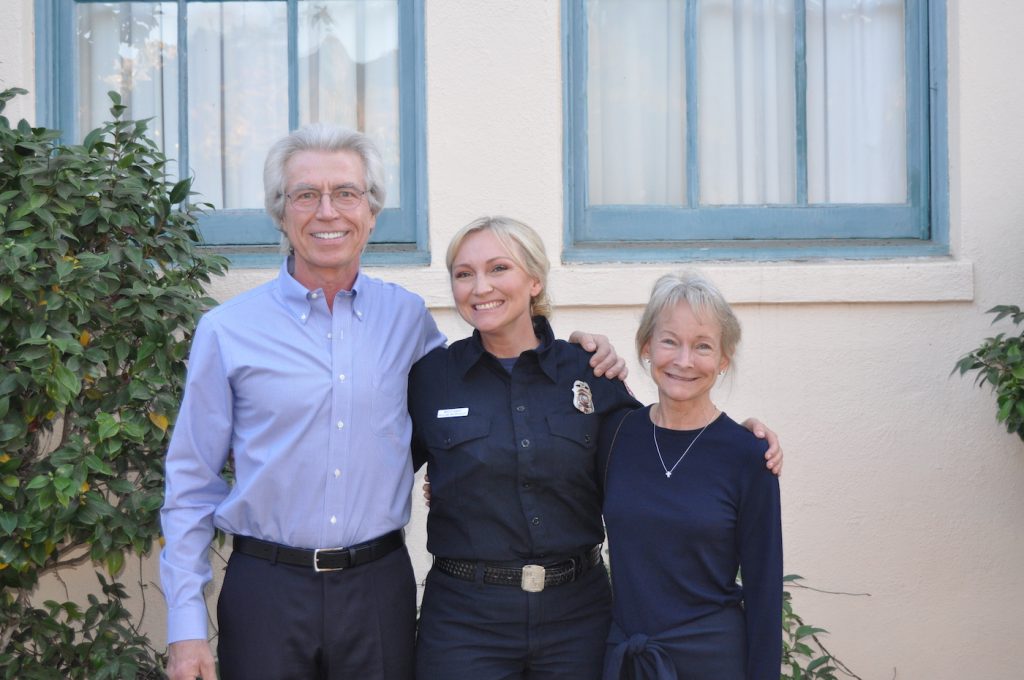
In October, MFPD hosted another very special awards ceremony, this time at Montecito Union School. The ceremony was to honor two MFPD firefighters for their courage and bravery during the 1/9 debris flow. Wildland Specialist Maeve Juarez and Firefighter/Paramedic Andrew Rupp were each given a Medal of Valor award, which is the highest honor awarded to public service personnel in the nation. This was the first and only time in MFPD’s 100-year history that a Medal of Valor has been awarded. “Receiving this award means that the recipient risked their own life to save another, and they did so with willful disregard for their own life and safety,” Chief Hickman said.
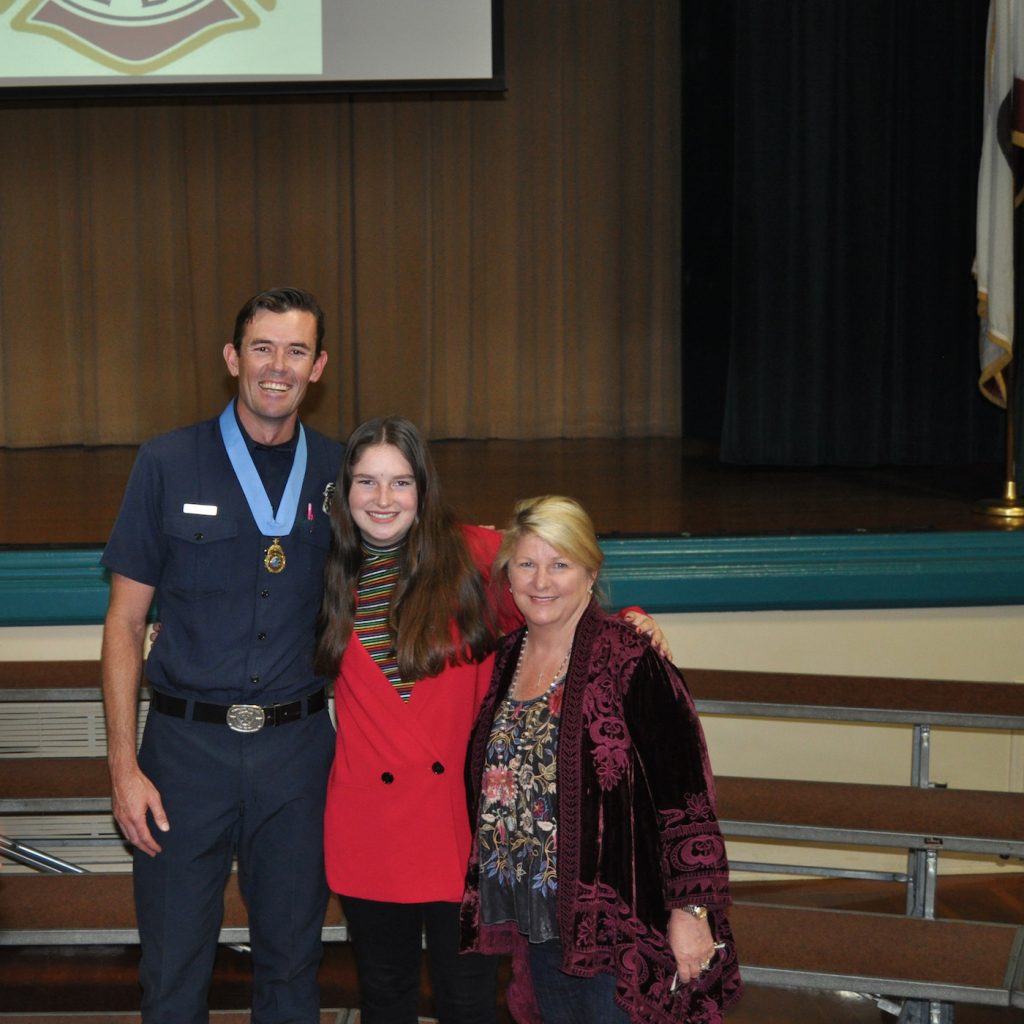
Maeve, who came to the District from the Forest Service, where she was a Division Chief, stepped up to the challenge of leading the eastern division during the expected rainstorm the night of January 9. Maeve was patrolling her division when rainfall reached .59 inches in five minutes, triggering the debris flow. Maeve had left the San Ysidro Creek Bridge 60 seconds prior to the bridge being swept away, and in her rear view mirror, she saw a tremendously large fireball. Without hesitation, Maeve quickly turned her vehicle around and headed back toward the flame. “With little concern for her own safety, Maeve engaged the area, encountering 200-foot flames coming from the ruptured high-pressure gas line, several homes on fire, and many destroyed from the debris flow,” Hickman said. While calling for resources, and directing her crews into the area, Maeve encountered Jon and Terry Keating. The Keatings had just jumped from the second story of their burning home; Jon sustained life threatening burn injuries and Terry couldn’t walk due to multiple fractures in both feet. Additionally, Terry’s clothing was torn off while escaping their burning home. Maeve extricated both Jon and Terry from the hazardous area, gave Terry the clothes off her back, quickly coordinated a night helicopter evacuation, and carried Terry on her back to safety, Hickman said.
The same morning, MFPD’s Engine 317 was engaged in search and rescue efforts in the Hot Springs/Olive Mill Road area. The crew of Engine 317 encountered multiple homes swept away and others severely damaged by the debris flow. “Entire trees ripped from their roots, extremely large boulders, and enormous piles of debris were everywhere,” Hickman said. “Power lines were tangled among the debris and high-pressure gas lines were ruptured, ejecting unburned natural gas with a deafening sound.” Andy Rupp and his crew heard 17-year-old Lauren Cantin’s faint cry for help coming from a nearby debris pile. The entire crew started de-layering the pile by hand in an effort to locate Lauren without igniting the natural gas that surrounded them. “Use of power tools was not an option,” Hickman said.
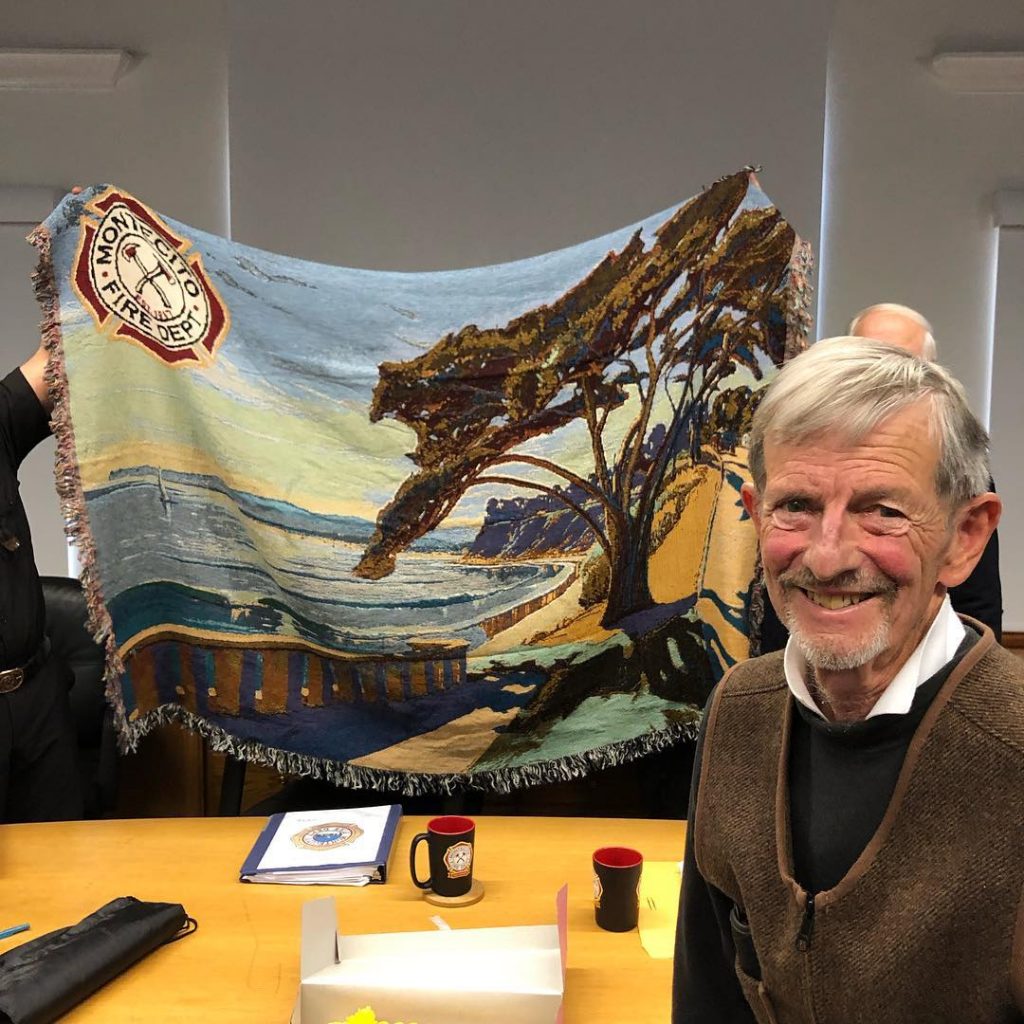
Rupp was the first to make contact with Lauren, trapped 10 feet deep in the debris. He promised her he would not leave her until she was safe. Andy began tunneling down towards Lauren among warnings of ensuing rain, further debris flow, and continued threat of the natural gas finding an ignition source. “Andy knew a rapid escape from the tunnel he was in was not possible if something went wrong,” Hickman said. After an hour of digging and cutting by hand, Andy finally made it down to Lauren. He was able to cut the last remaining debris, freeing Lauren’s ankle and extricating her from the pile. Andy never left Lauren’s side until he delivered her to the ambulance. Lauren and her mother, Kim Cantin, would later discover their father and husband, Dave Cantin, perished in the debris flow. Lauren’s brother, Jack Cantin, remains missing.
Both the Keating family and the Cantin family were in attendance at the special event. Juarez and Rupp were given a standing ovation for their heroic efforts, while their new medals were placed around their necks.
MFPD partner in disaster preparedness is the volunteer network, MERRAG (Montecito Emergency Response and Recovery Action Group), which kept busy this year holding monthly trainings and supporting the efforts of the Fire District. In December, MERRAG helped to coordinate a large-scale effort to go door-to-door to notify those living in an debris flow risk area. Over 150 volunteers turned out to help distribute packets of information to those living in at-risk areas.
The MFPD recently announced a vacancy on its Board of Directors left by John Venable, who served the District for 16 years; interested persons should apply no later than January 23, 2019.
Montecito Water & Sanitary Districts
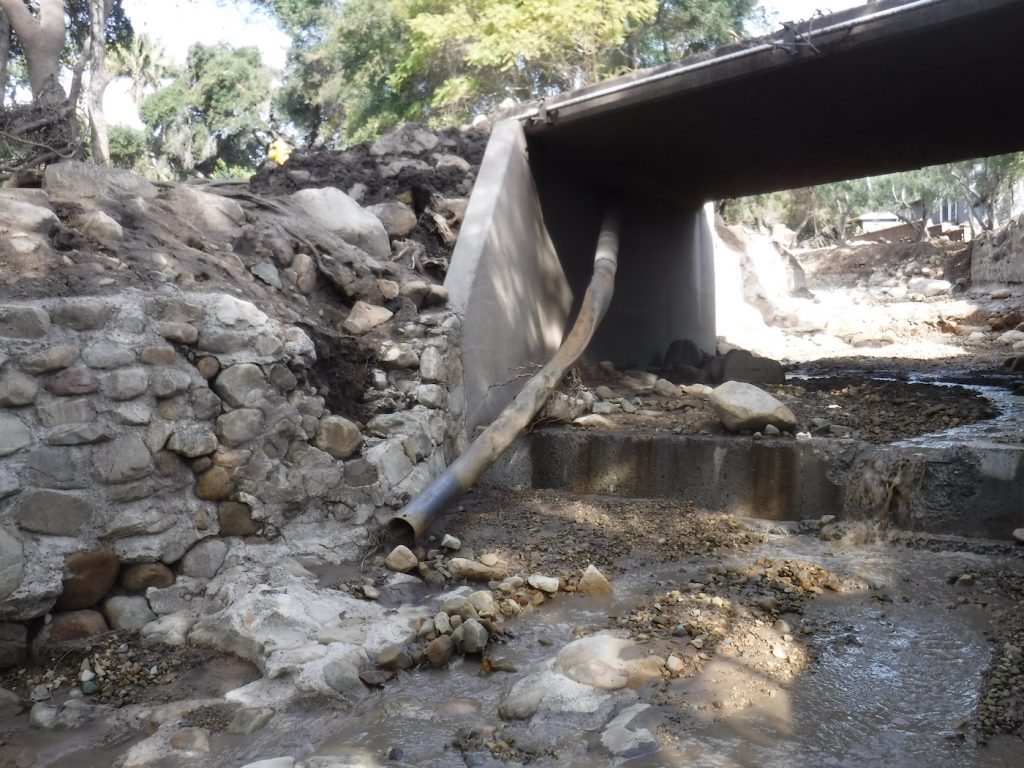
The mid-term election in November filled the pages of several issues of the Journal in 2018. In August it was announced that five candidates would be running together to fill seats on the Water District and Sanitary District boards. Calling themselves “the Montecito and Summerland Water Security Team,” the slate of candidates included Woody Barrett and Dana Newquist (both running for MSD), and Cori Hayman, Ken Coates, and Brian Goebel (all three running for MWD). The candidates won the two seats at the Sanitary District, held by incumbents Judy Ishkanian and Bob Williams. Three seats were up for grabs at MWD; incumbent Dick Shaikewitz lost his bid for re-election while directors Doug Morgan and Sam Frye stepped down from the Board at the end of their terms. Following the election, Montecito Sanitary District appointed former MA Land Use Chair Tom Bollay to a seat left vacant by Warner Owens.
Infrastructure from both Districts was affected by the 1/9 debris flow, and both MSD general manager Diane Gabriel and MWD general manager Nick Turner kept the community up-to-date on the rebuilding, as well as the happenings of their respective Districts throughout the year. The estimated damage to MSD’s infrastructure was $1.6 million; the majority of which is being repaid through a grant from FEMA.
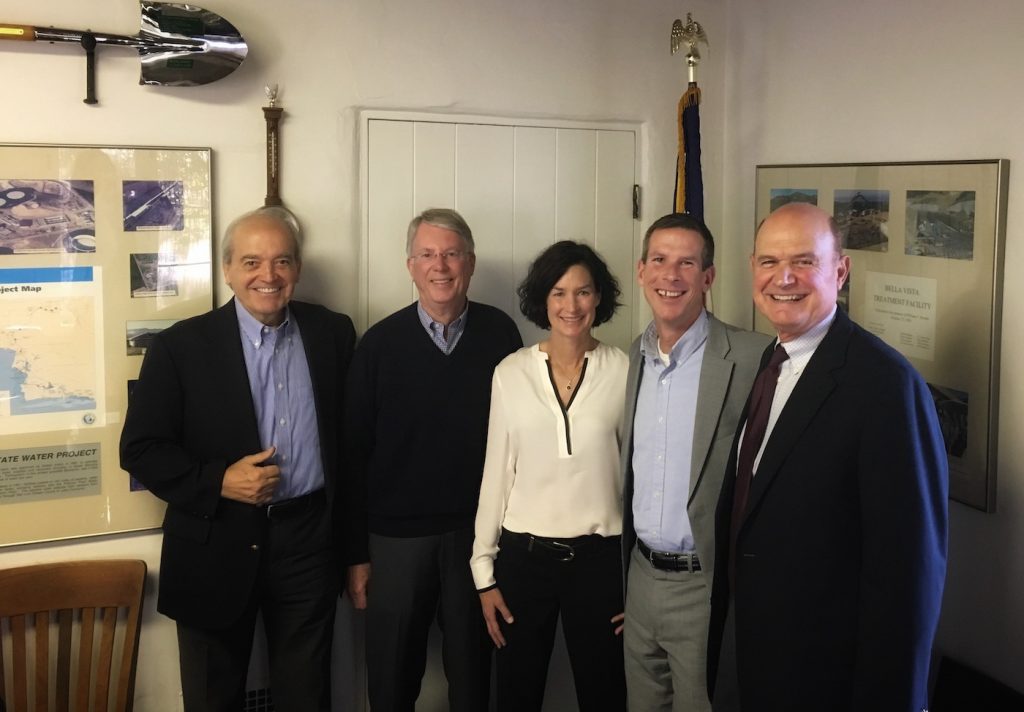
Both Districts continue to contend with the drought, and have committed to working together in the coming years to come to an agreement on recycled water. In September, the MSD voted on a resolution to clarify that MSD has been and continues to be ready and willing to recycle wastewater discharged to the public sanitary sewer system from inside homes and businesses in Montecito. The MWD Board of Directors will soon decide on the type of water recycling project that is best suited for their service area, and once that decision is made by the MWD Board, both Districts are prepared to work together to make it happen. In the meantime, MSD is working on a pilot facility for recycled water to be used for District landscaping.
In 2019 we can expect to see progress on the installation of Smart Meters by the MWD, as well as the completion of the infrastructure fixes stemming from the debris flow.
Thank You!
As always, we’d like to extend a big THANK YOU to our supporters, advertisers, contributors, and most importantly, our readers, without whom we would not be able to put this publication together week after week, for over two decades.
We’ll see you in 2019!







